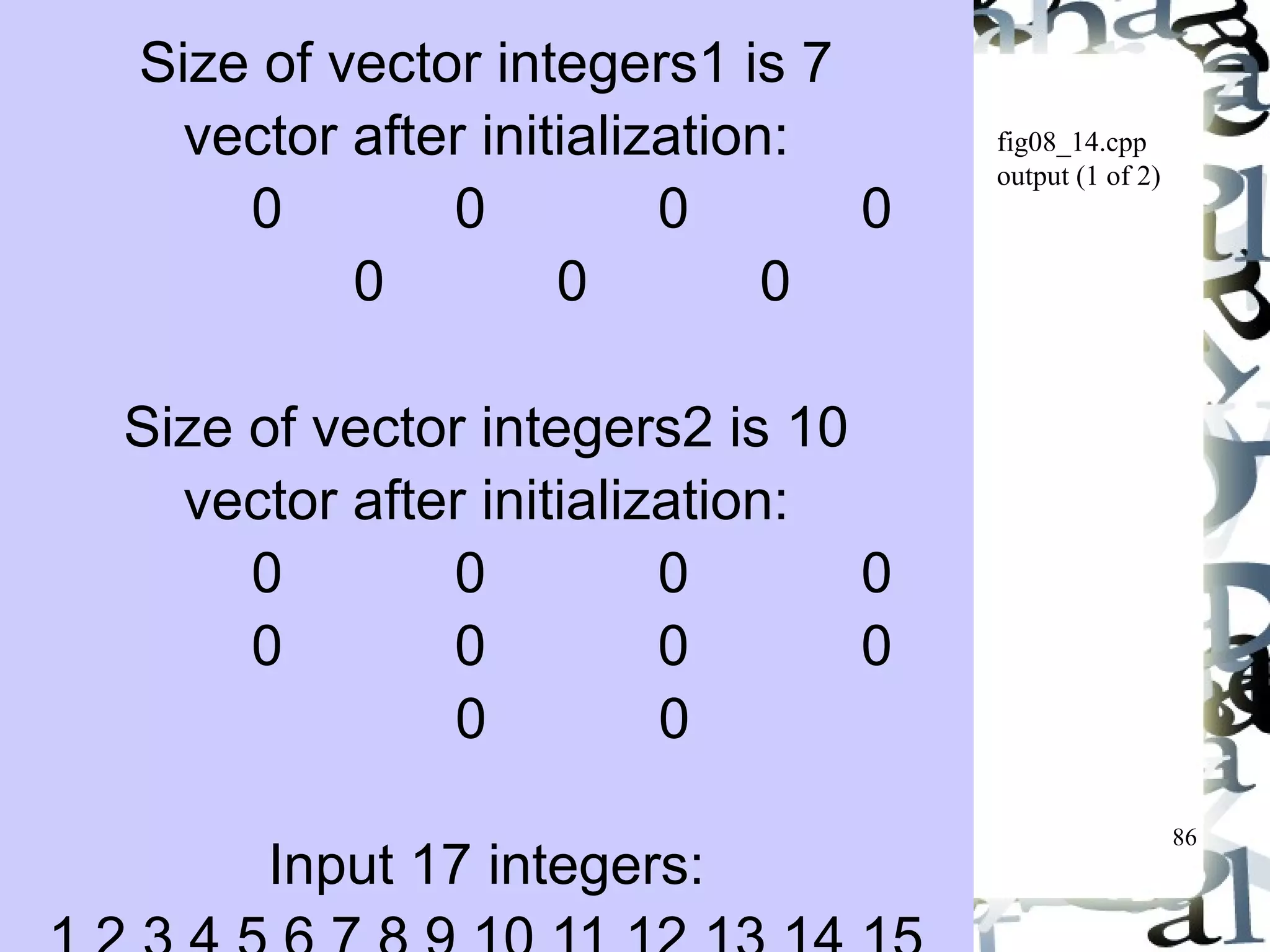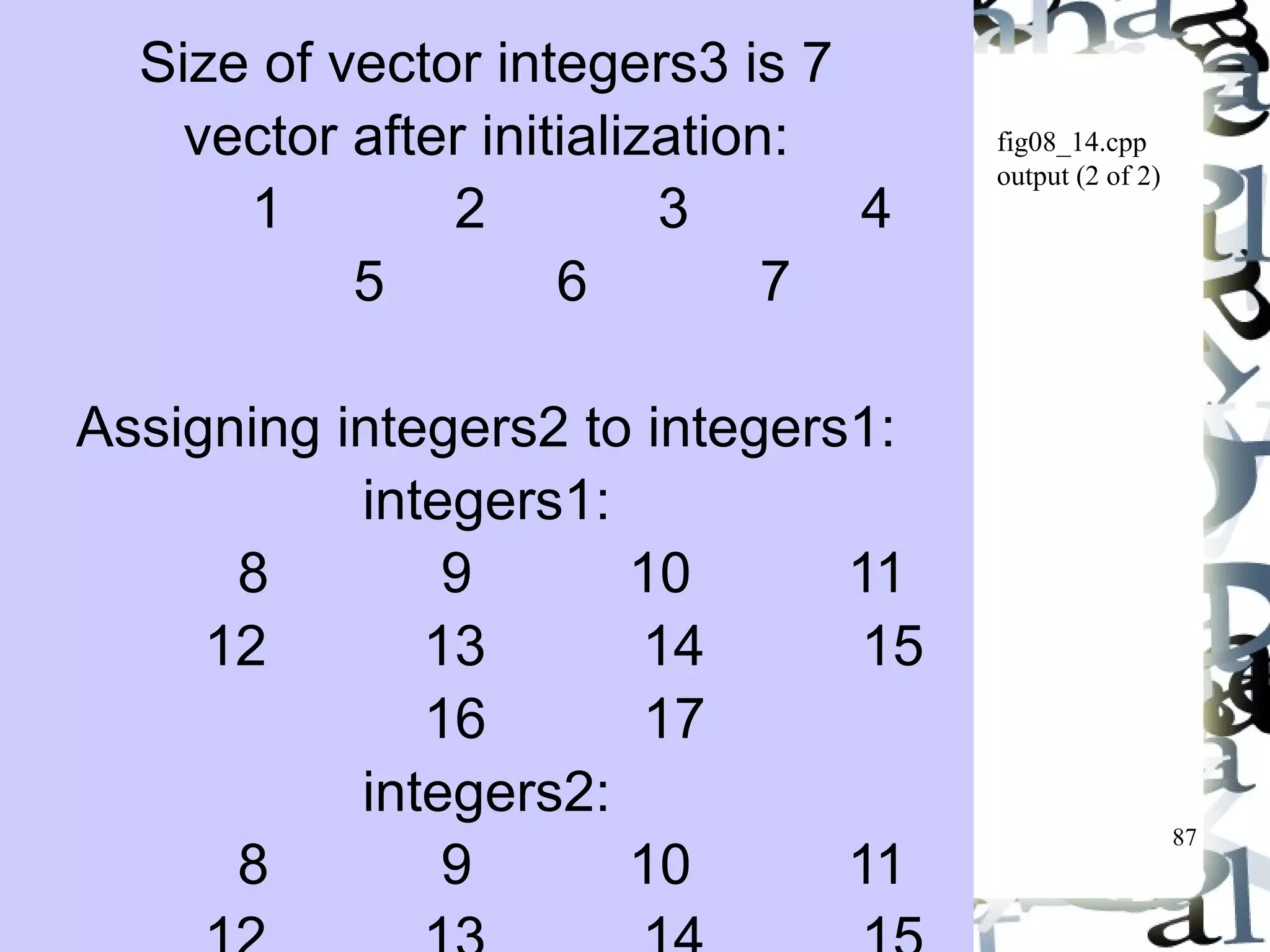The document discusses operator overloading in C++. It covers the fundamentals of operator overloading including which operators can be overloaded and restrictions. It provides examples of overloading unary, binary, and assignment operators. It also discusses overloading stream insertion and extraction operators and includes a case study overloading operators for an Array class. The case study demonstrates overloading operators like ==, !=, [], and << to provide functionality like array comparisons and outputting entire arrays. The document also discusses converting between types using cast operators.
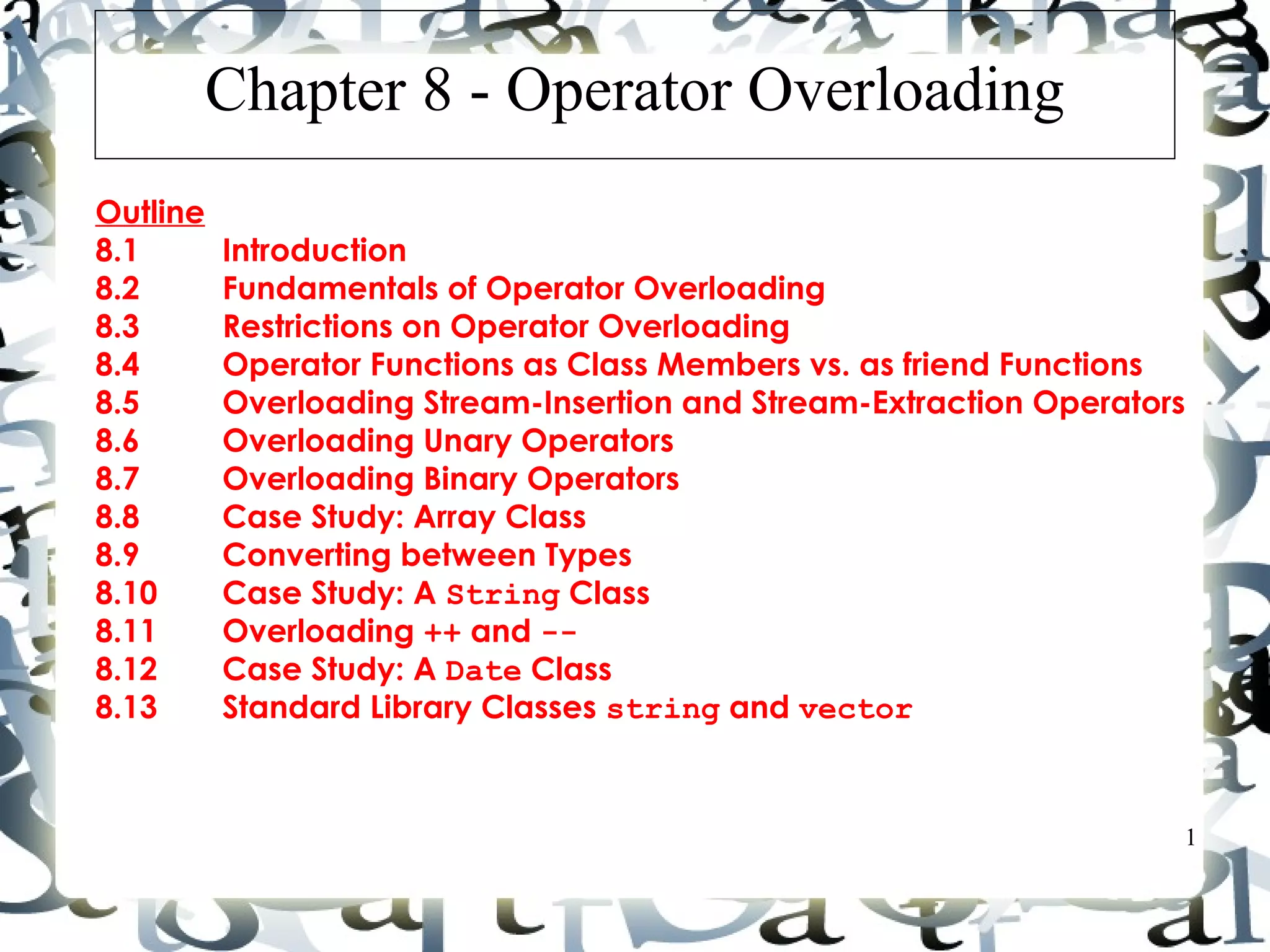
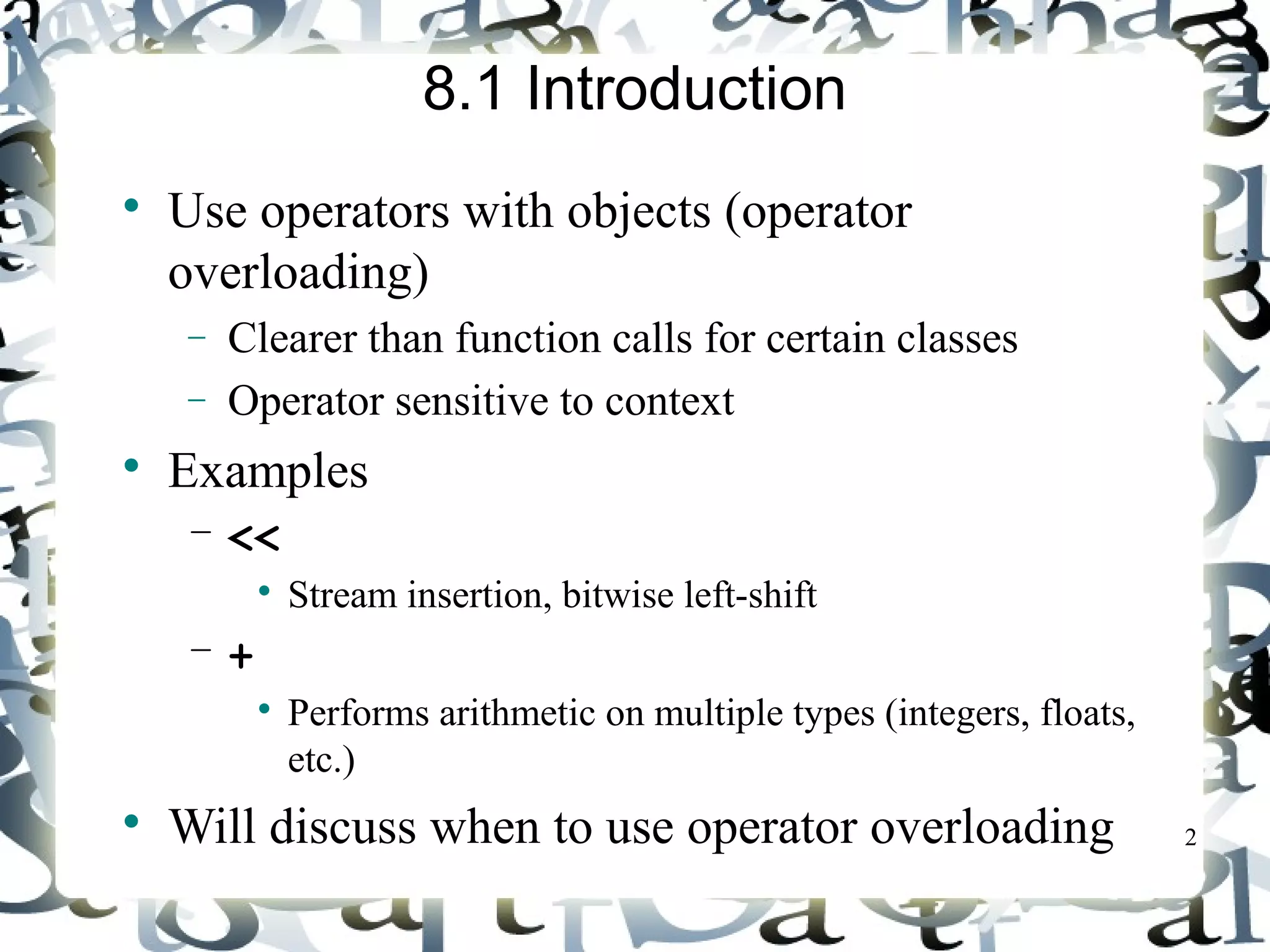
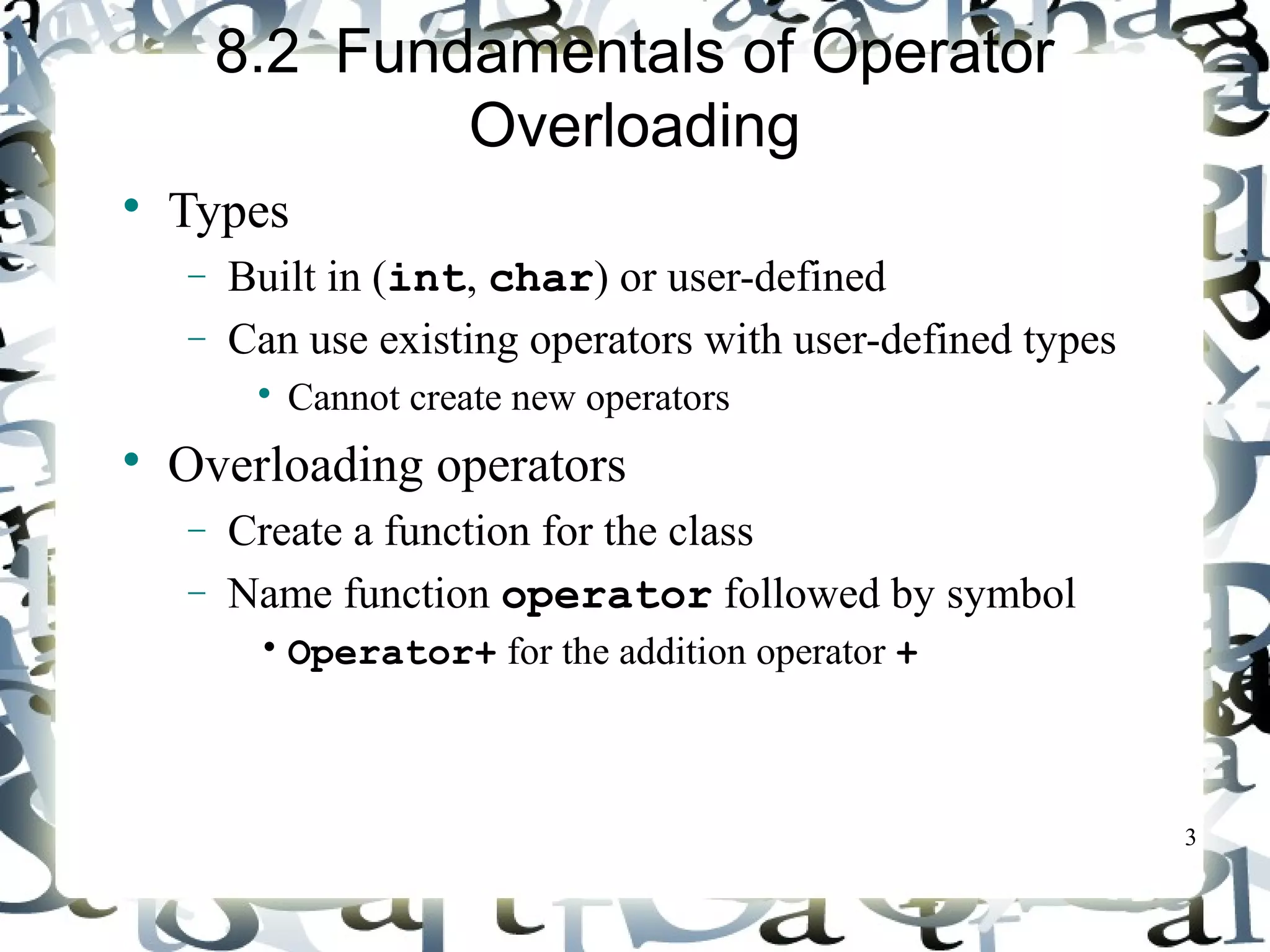
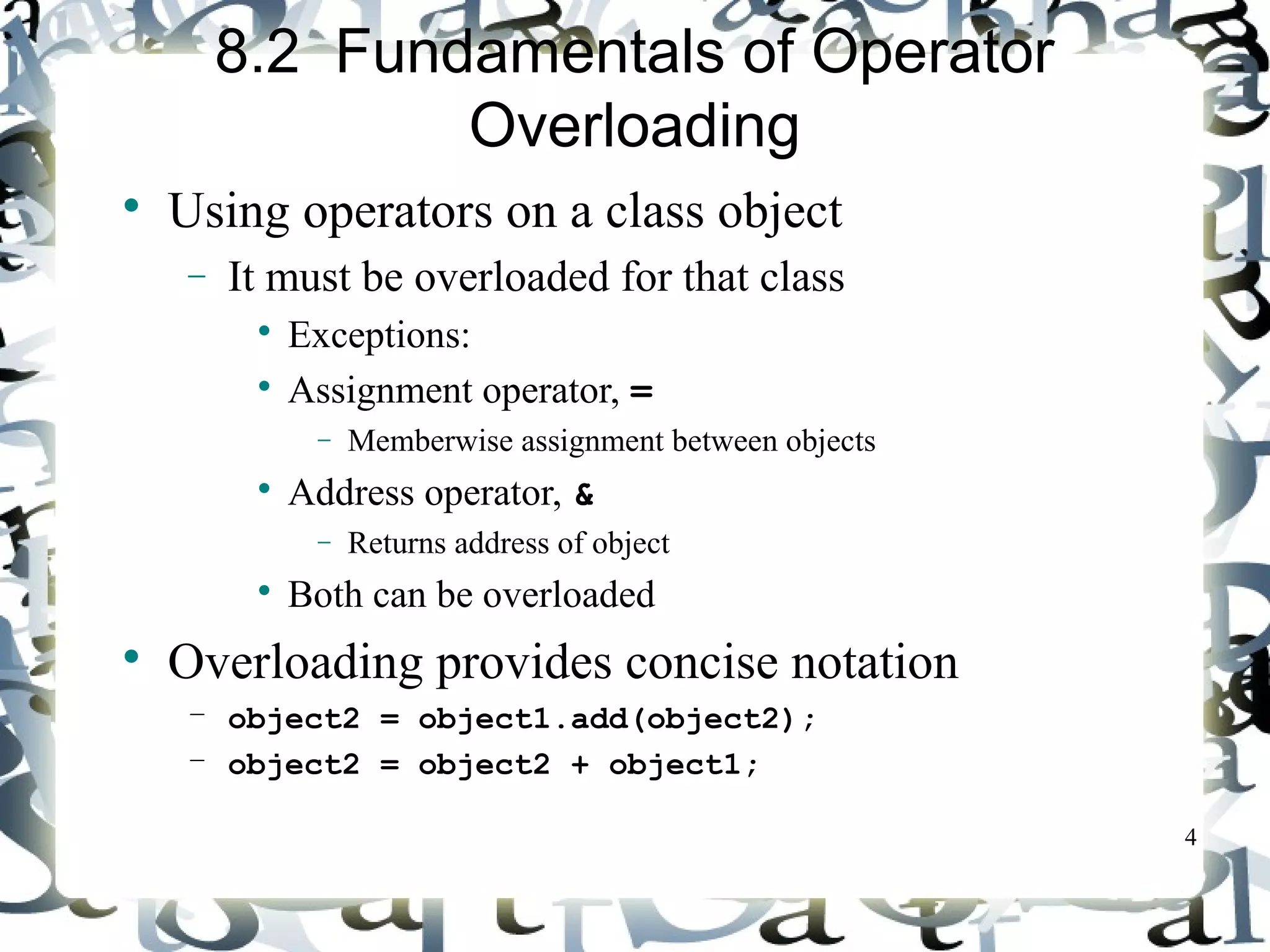
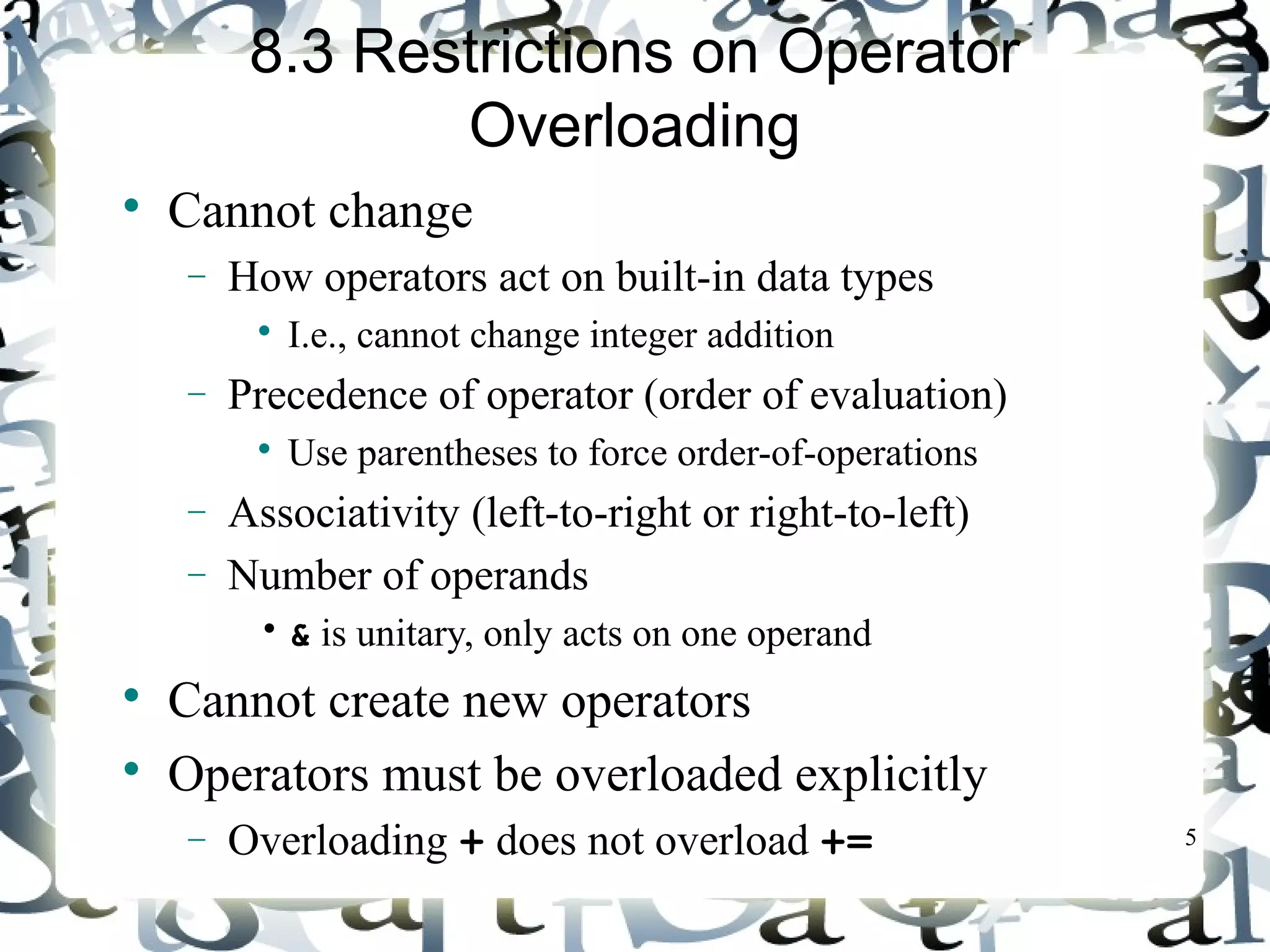
![6
8.3 Restrictions on Operator
Overloading
Operators that can be overloaded
+ - * / % ^ & |
~ ! = < > += -= *=
/= %= ^= &= |= << >> >>=
<<= == != <= >= && || ++
-- ->* , -> [] () new delete
new[] delete[]
Operators that cannot be overloaded
. .* :: ?: sizeof](https://image.slidesharecdn.com/synapseindiacomplainsharinginfoonchapter8-operatoroverloading-141101045042-conversion-gate02/75/Synapse-india-complain-sharing-info-on-chapter-8-operator-overloading-6-2048.jpg)
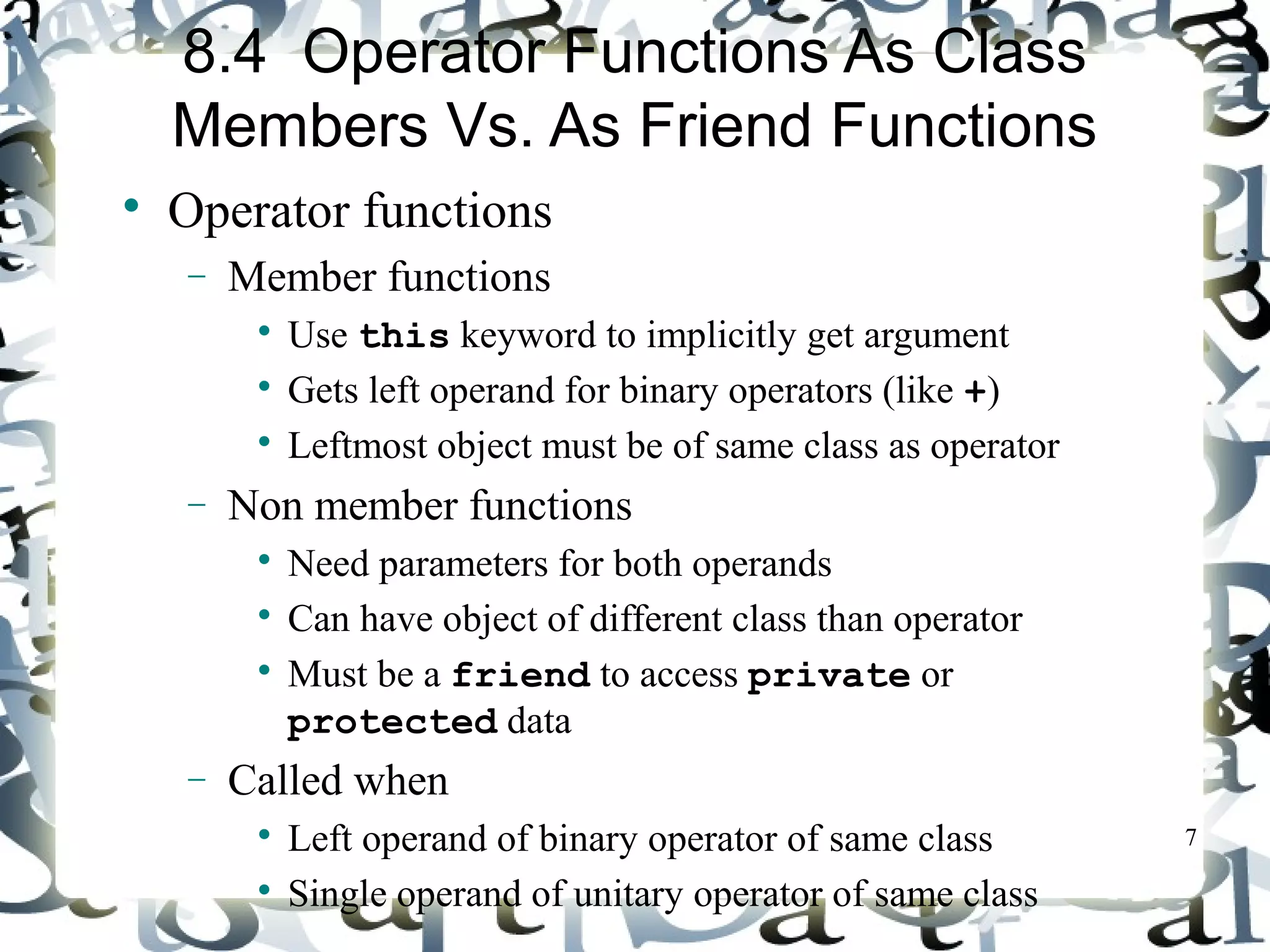
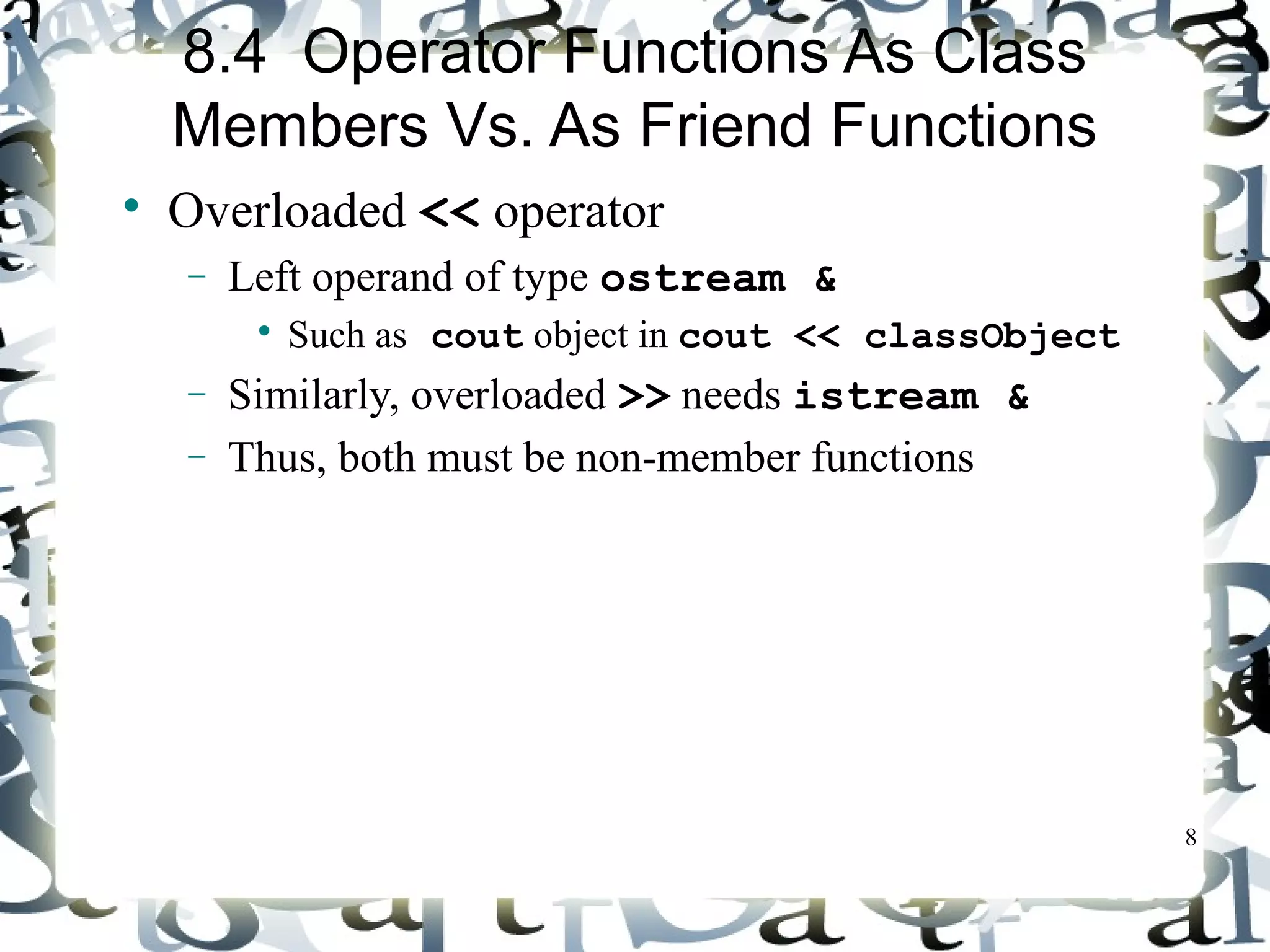
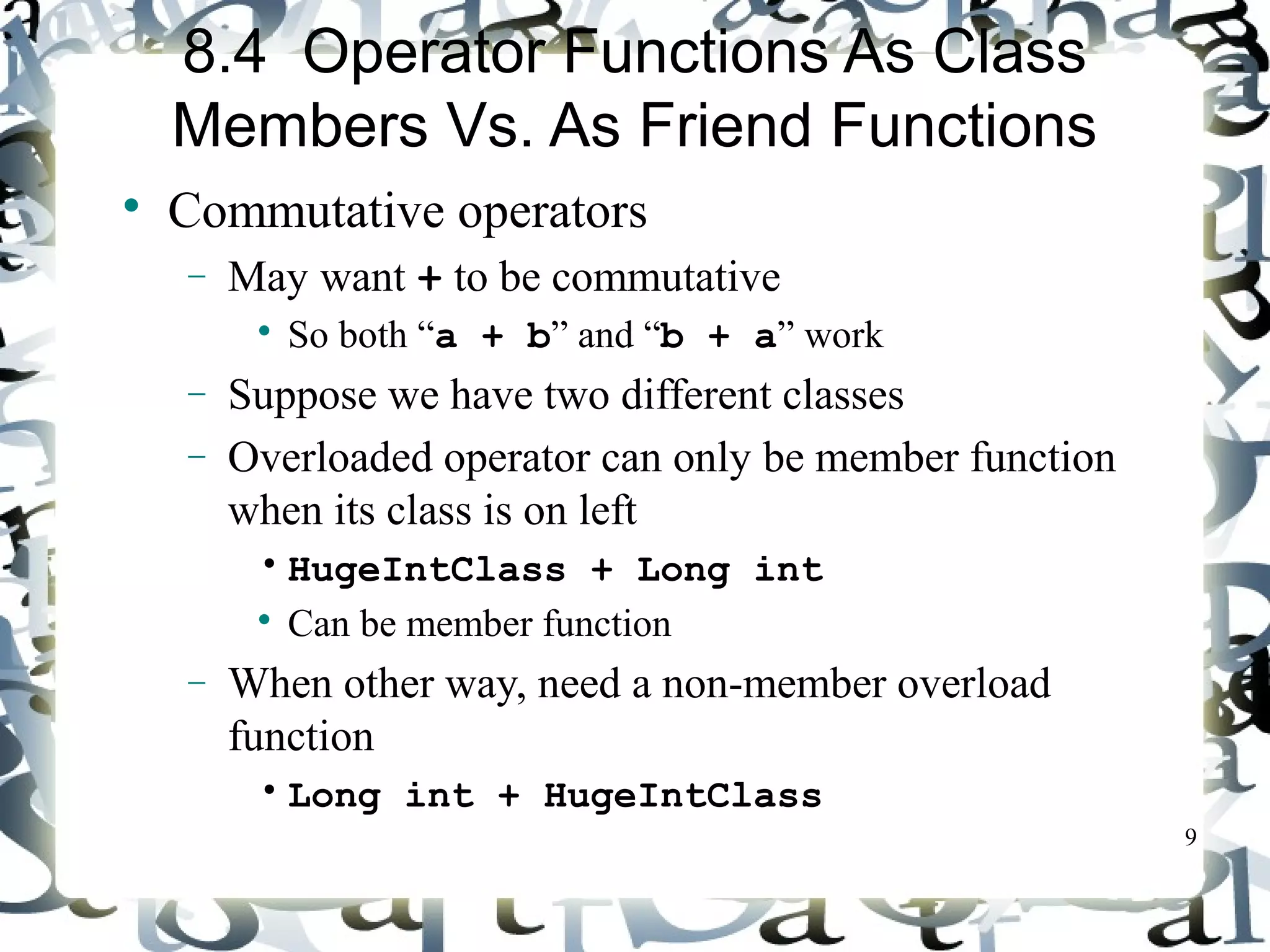
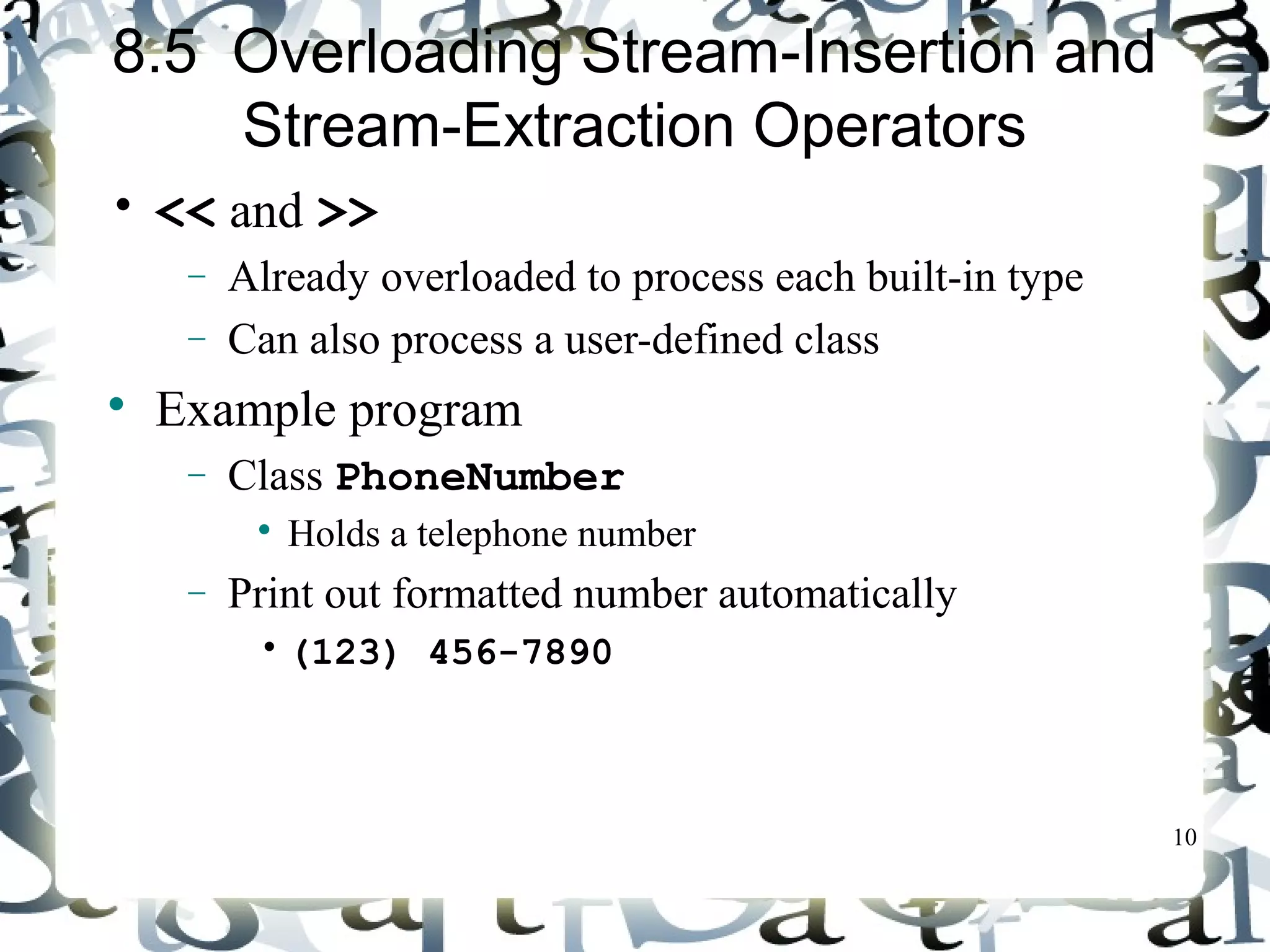
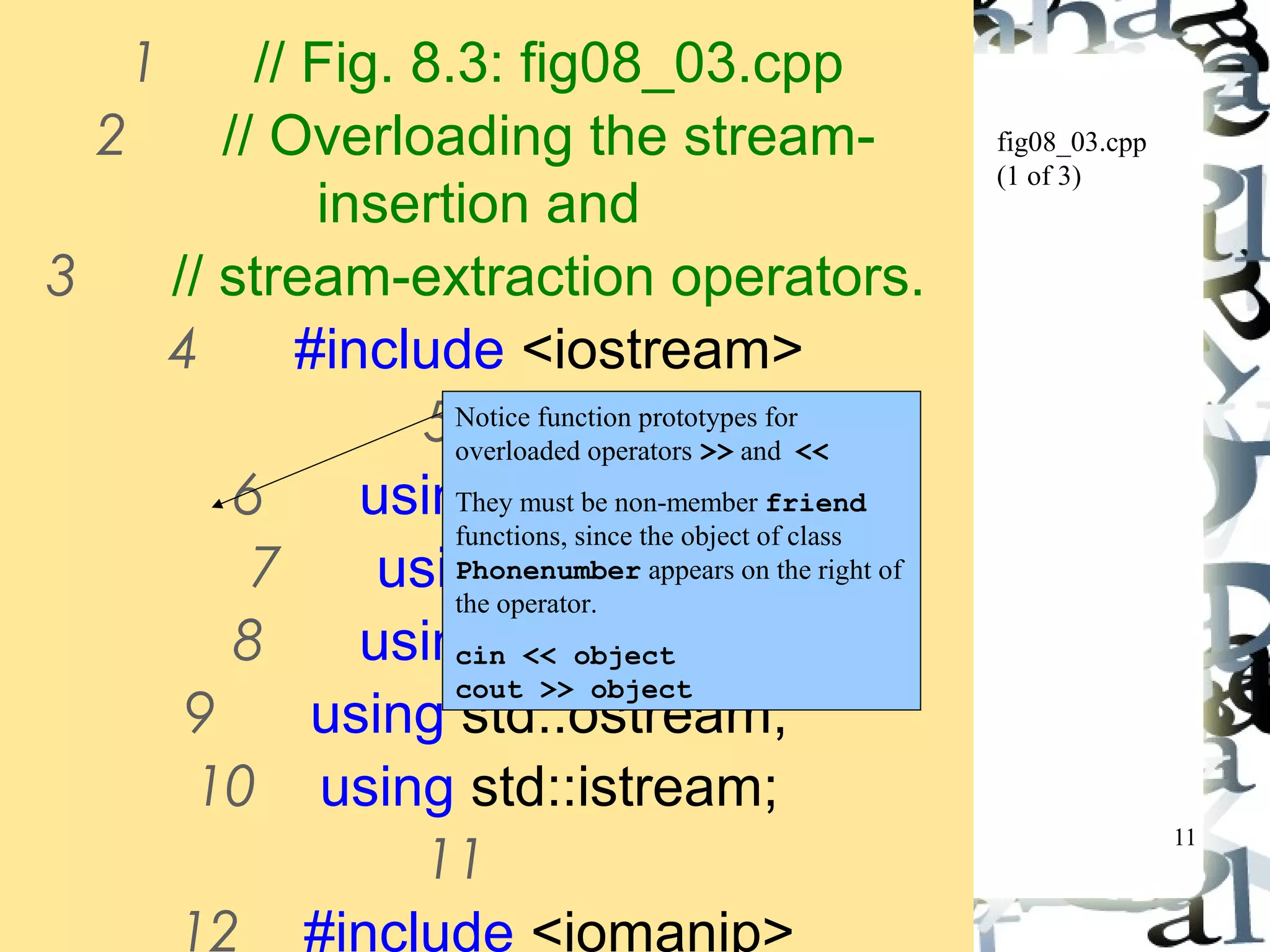

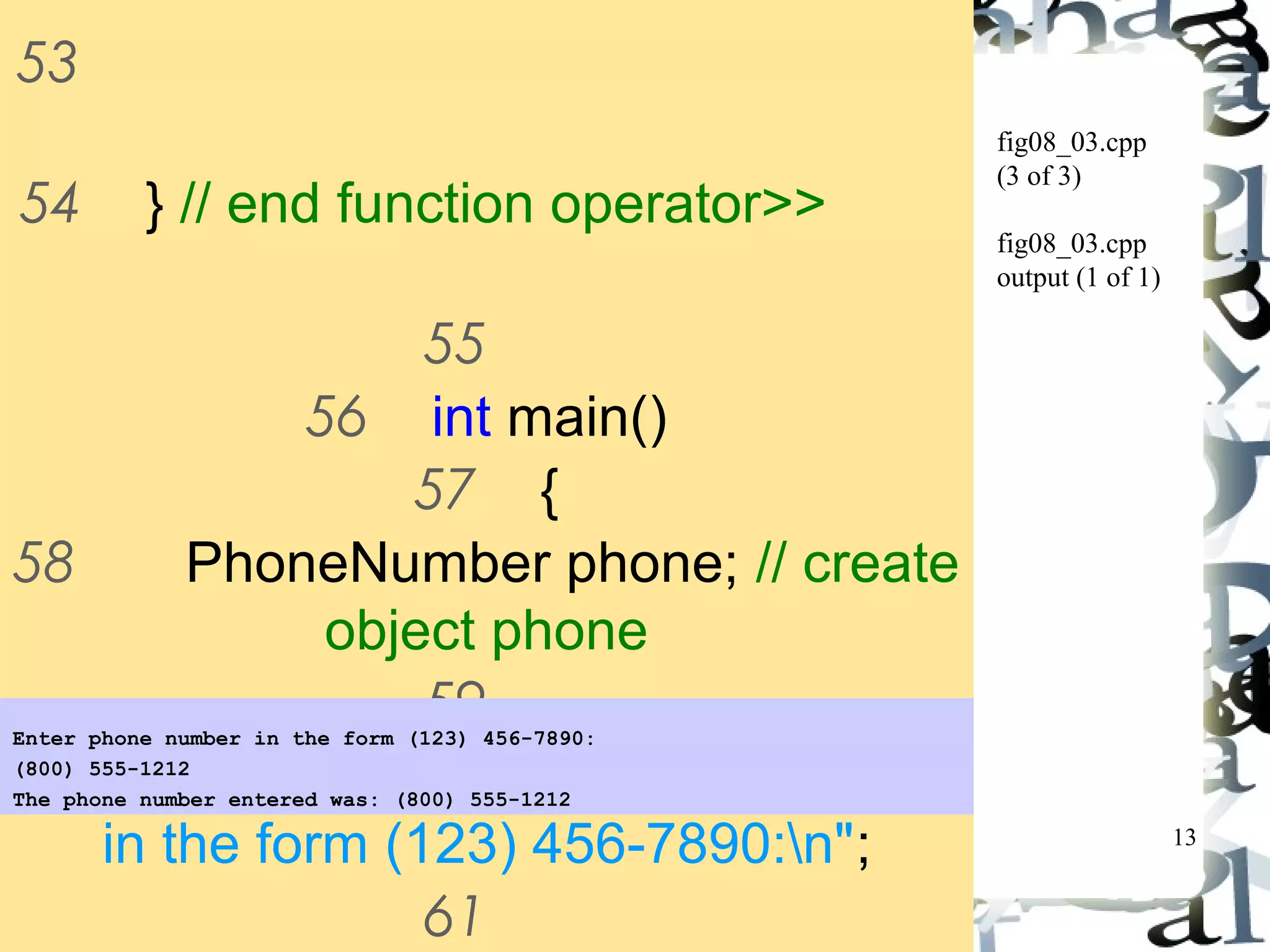
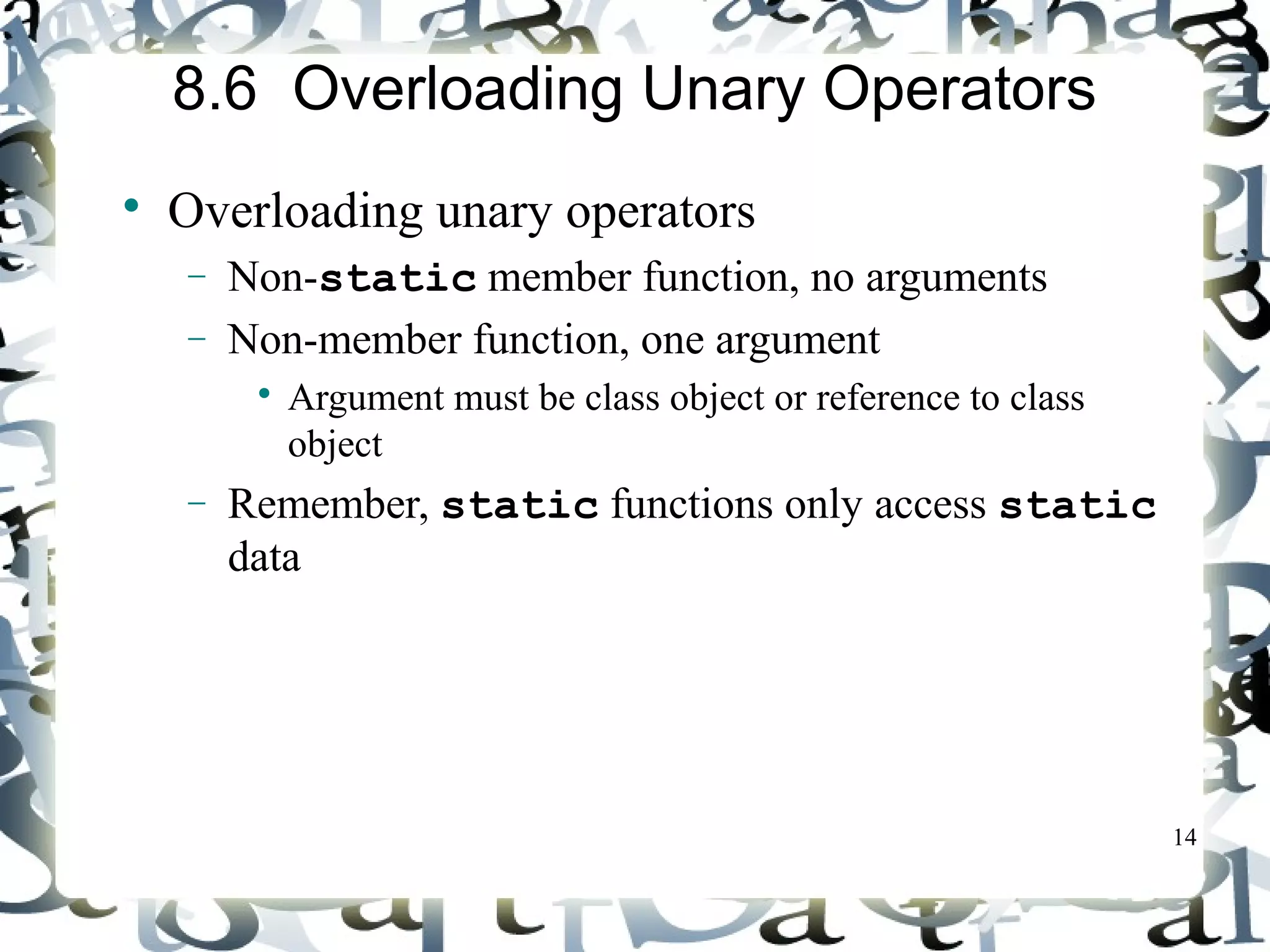
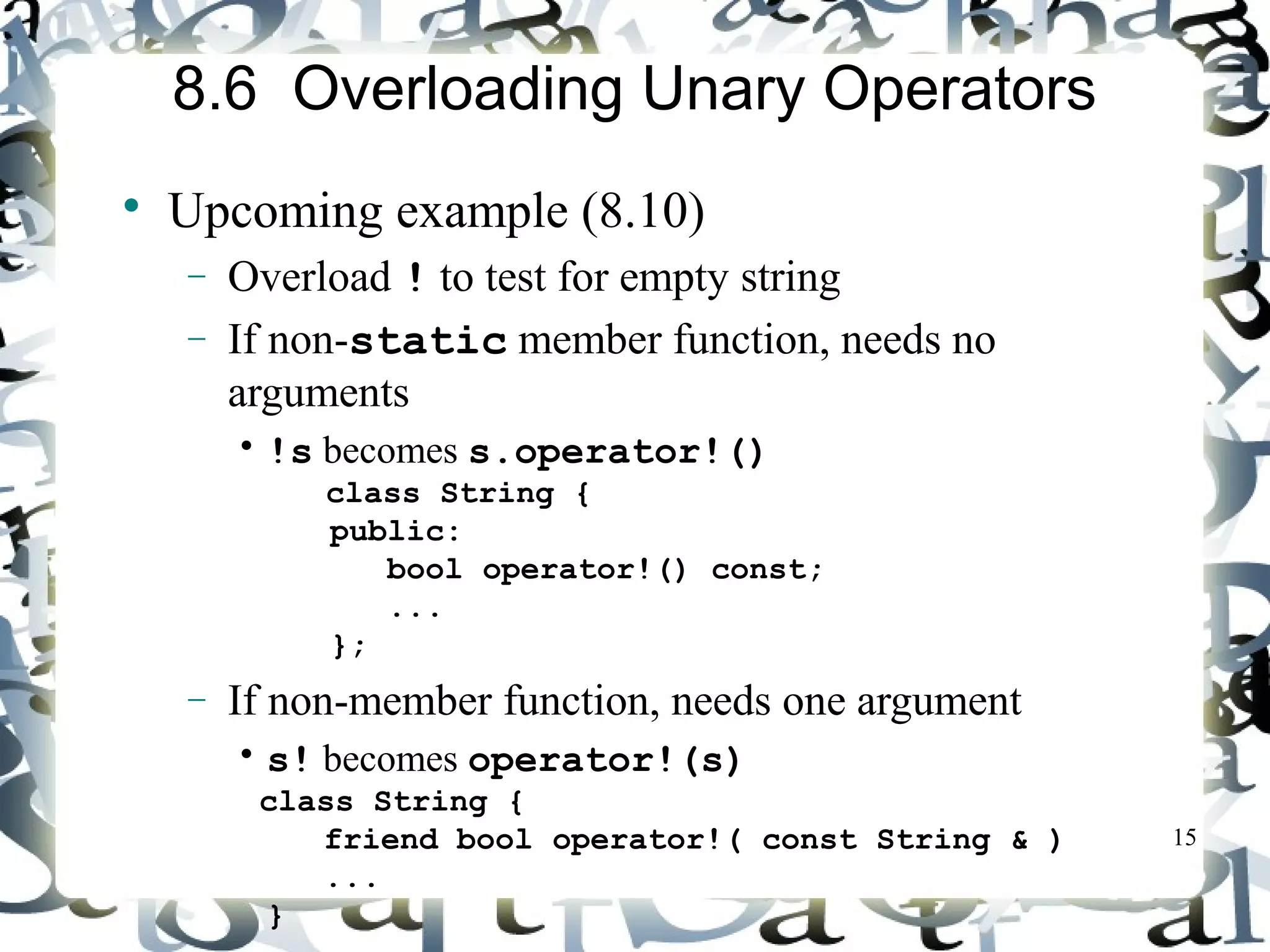


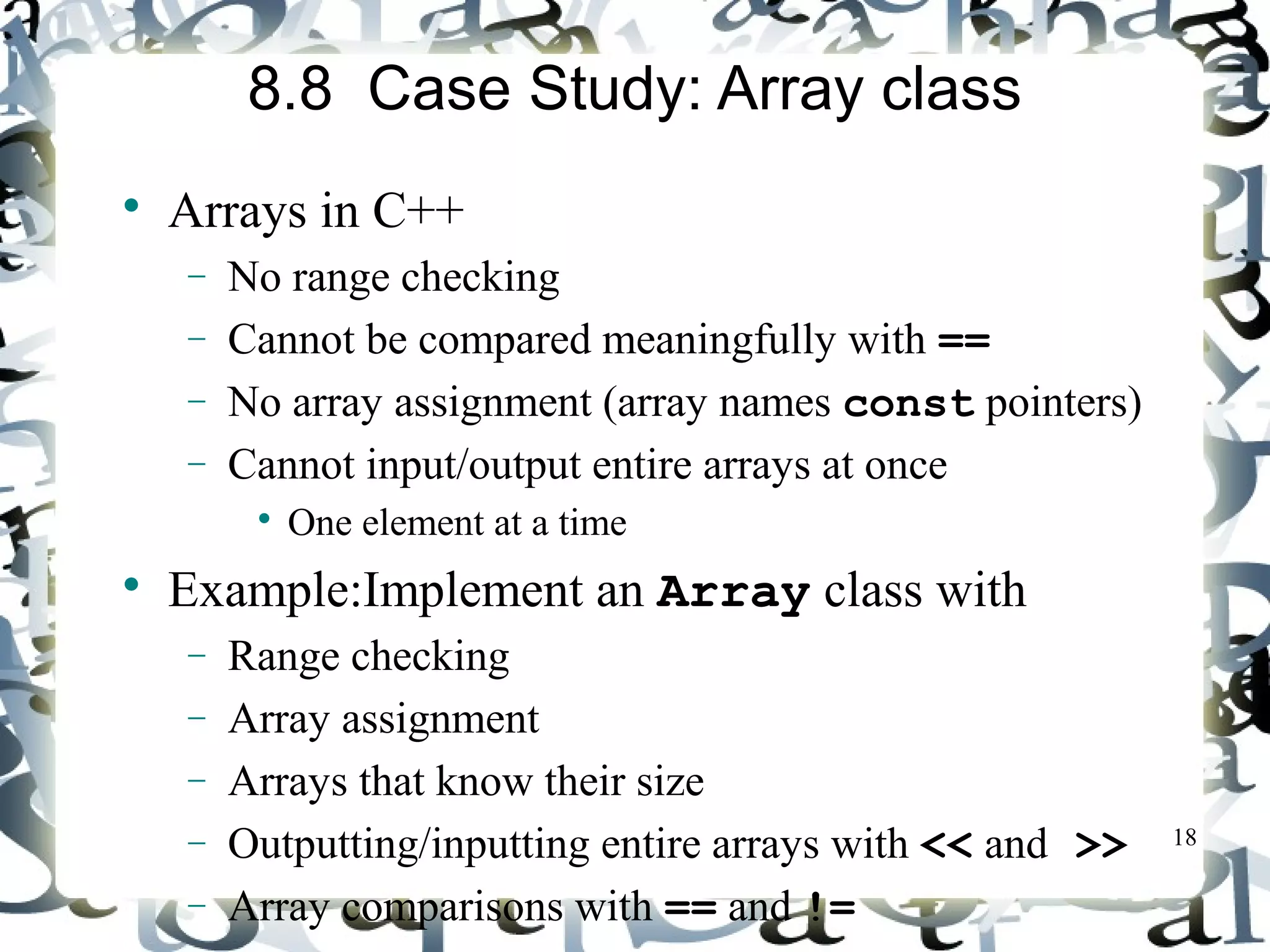
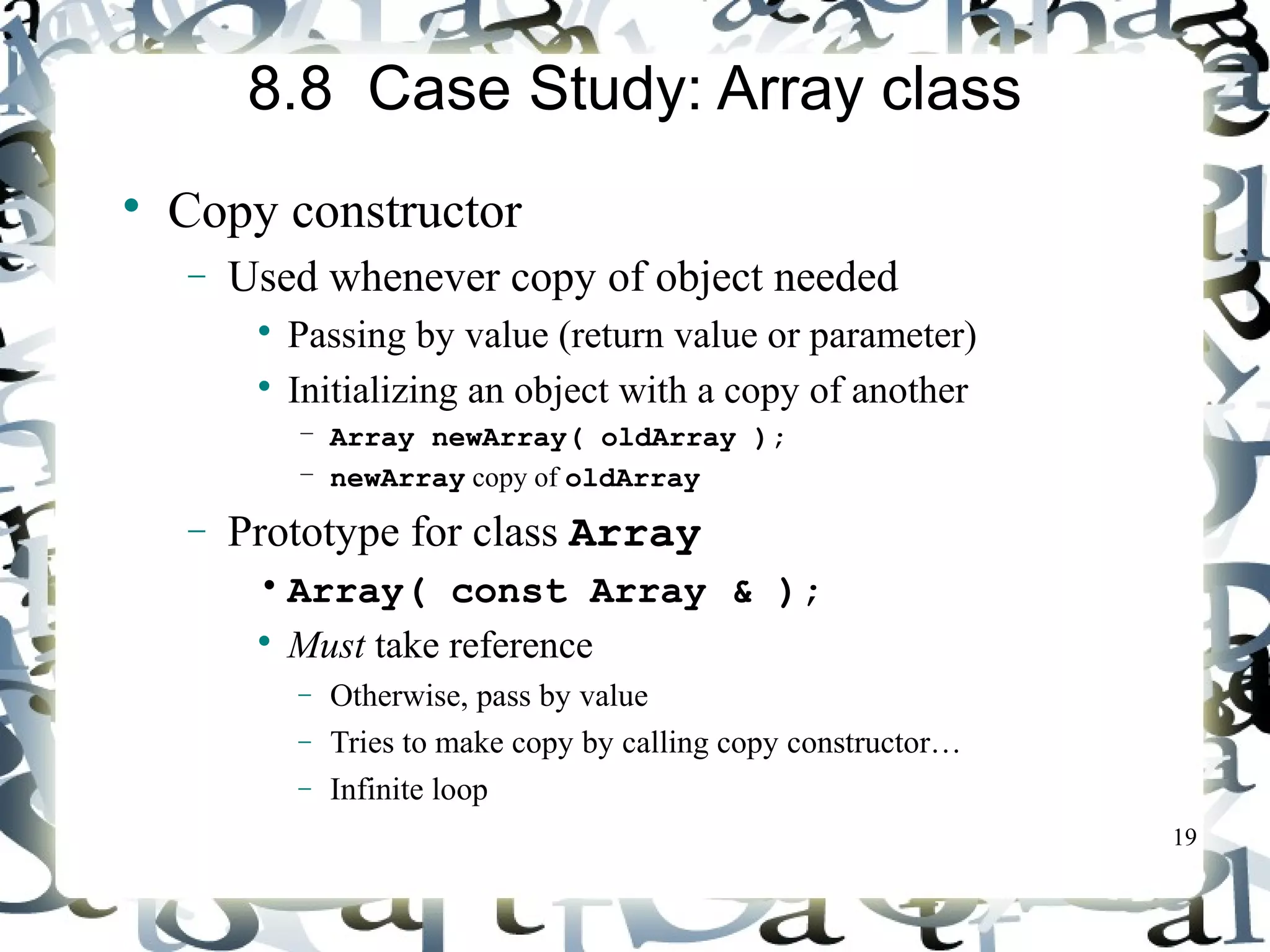
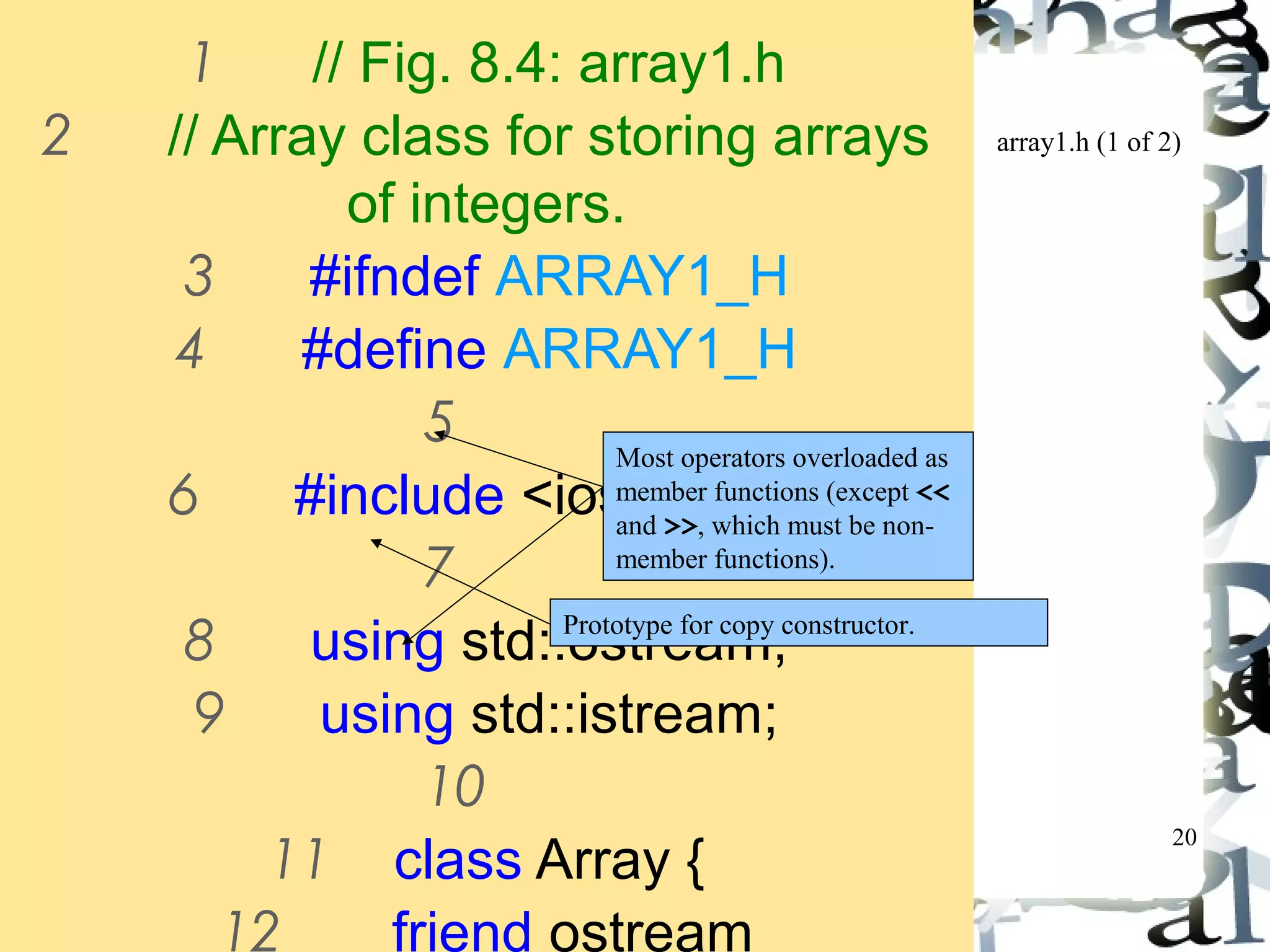
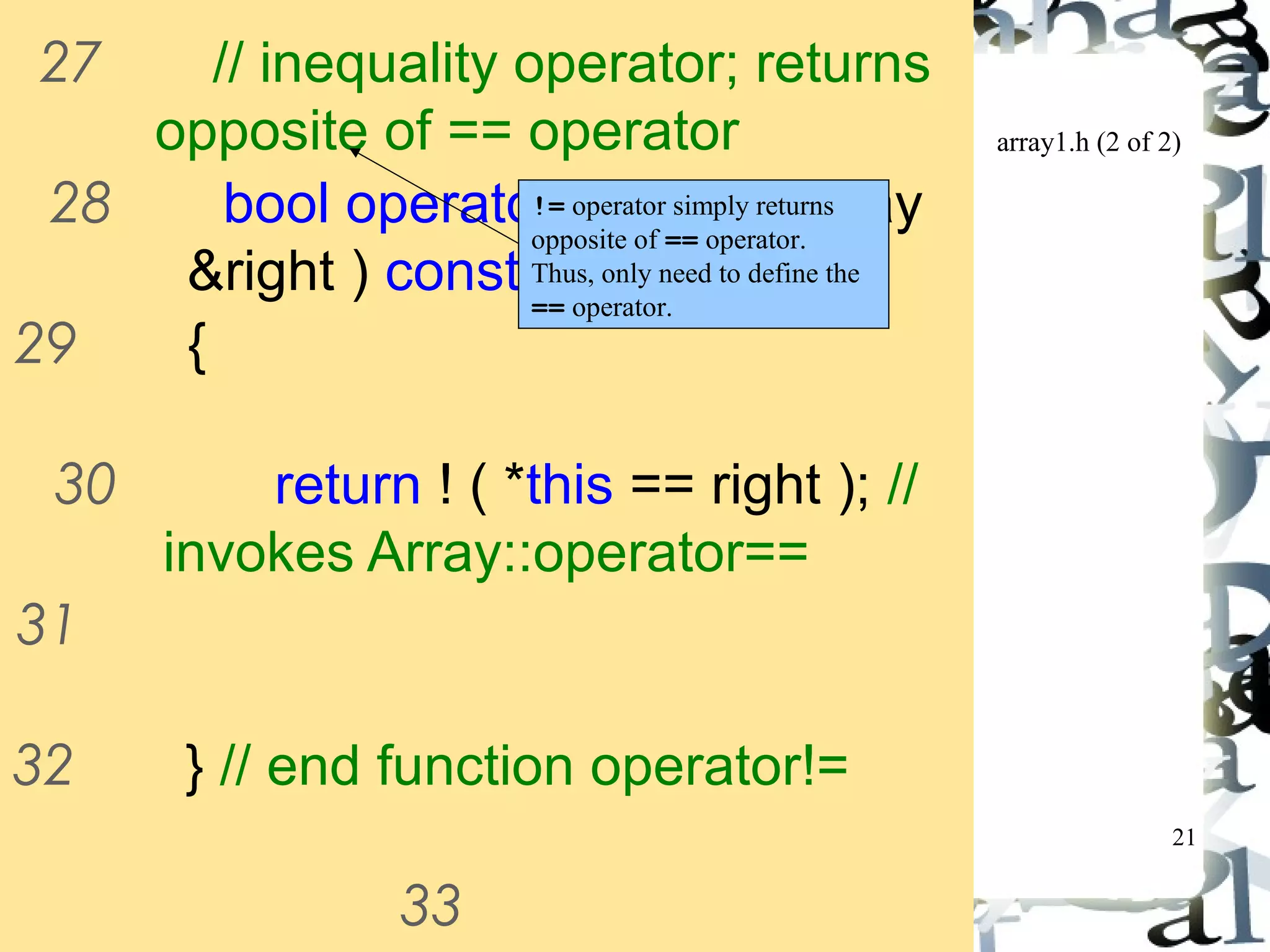
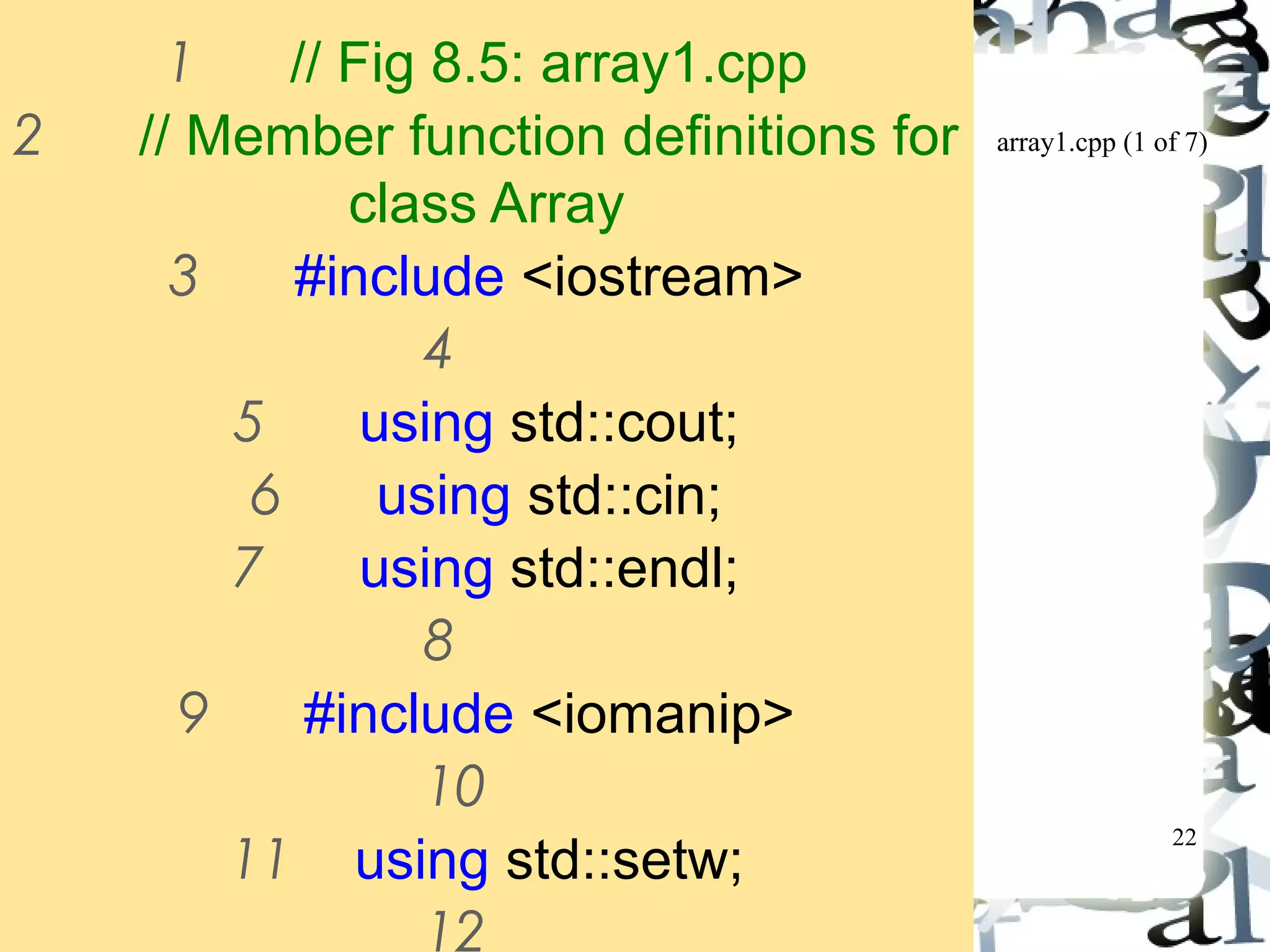
![array1.cpp (2 of 7)
23
27 for ( int i = 0; i < size; i++ )
28 ptr[ i ] = 0; // initialize
array
29
We must declare a new integer array so
the objects do not point to the same
memory.
30 } // end Array default constructor
31
32 // copy constructor for class
Array;
33 // must receive a reference to
prevent infinite recursion
34 Array::Array( const Array
&arrayToCopy )
35 : size( arrayToCopy.size )
36 {](https://image.slidesharecdn.com/synapseindiacomplainsharinginfoonchapter8-operatoroverloading-141101045042-conversion-gate02/75/Synapse-india-complain-sharing-info-on-chapter-8-operator-overloading-23-2048.jpg)
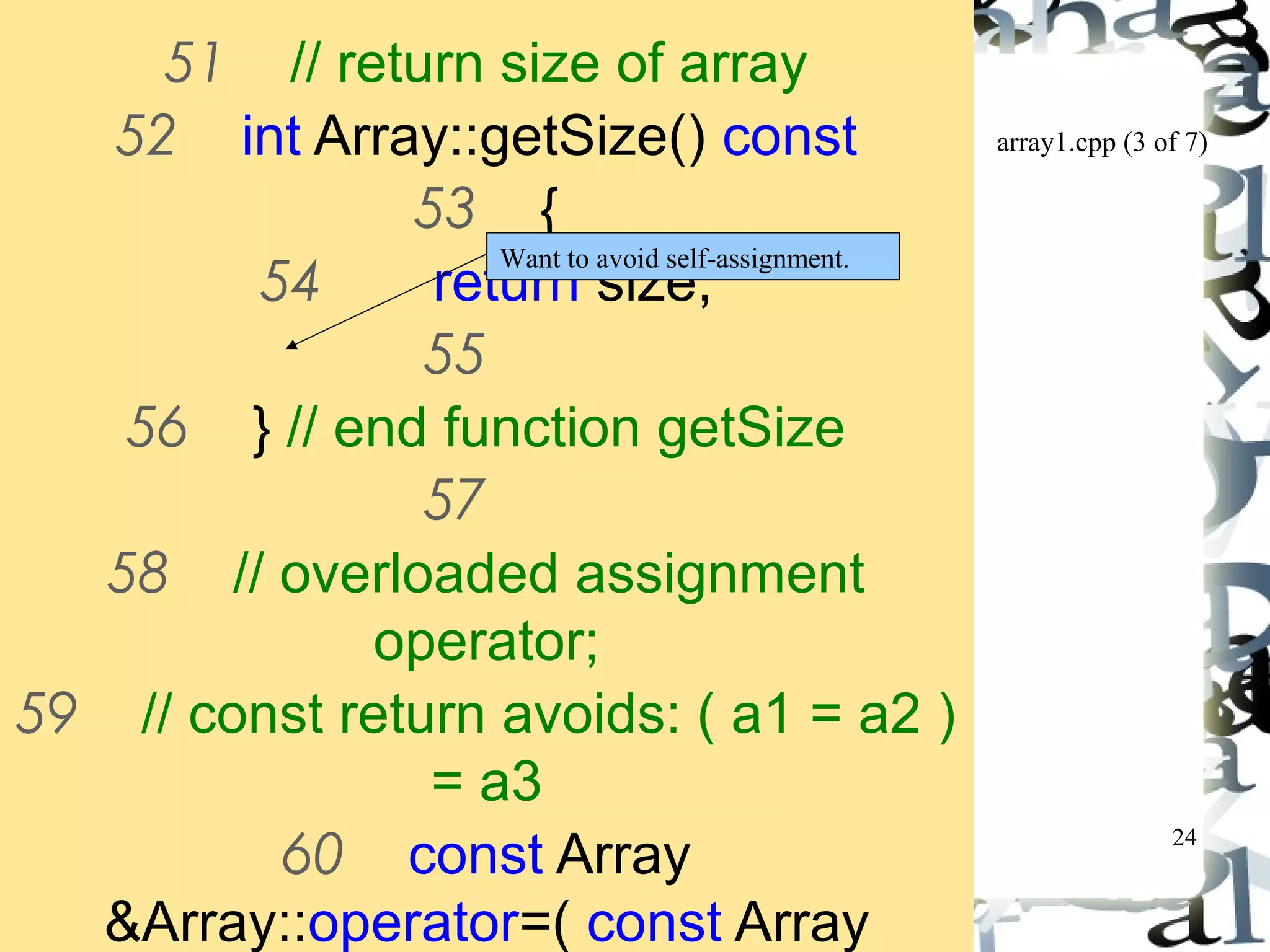
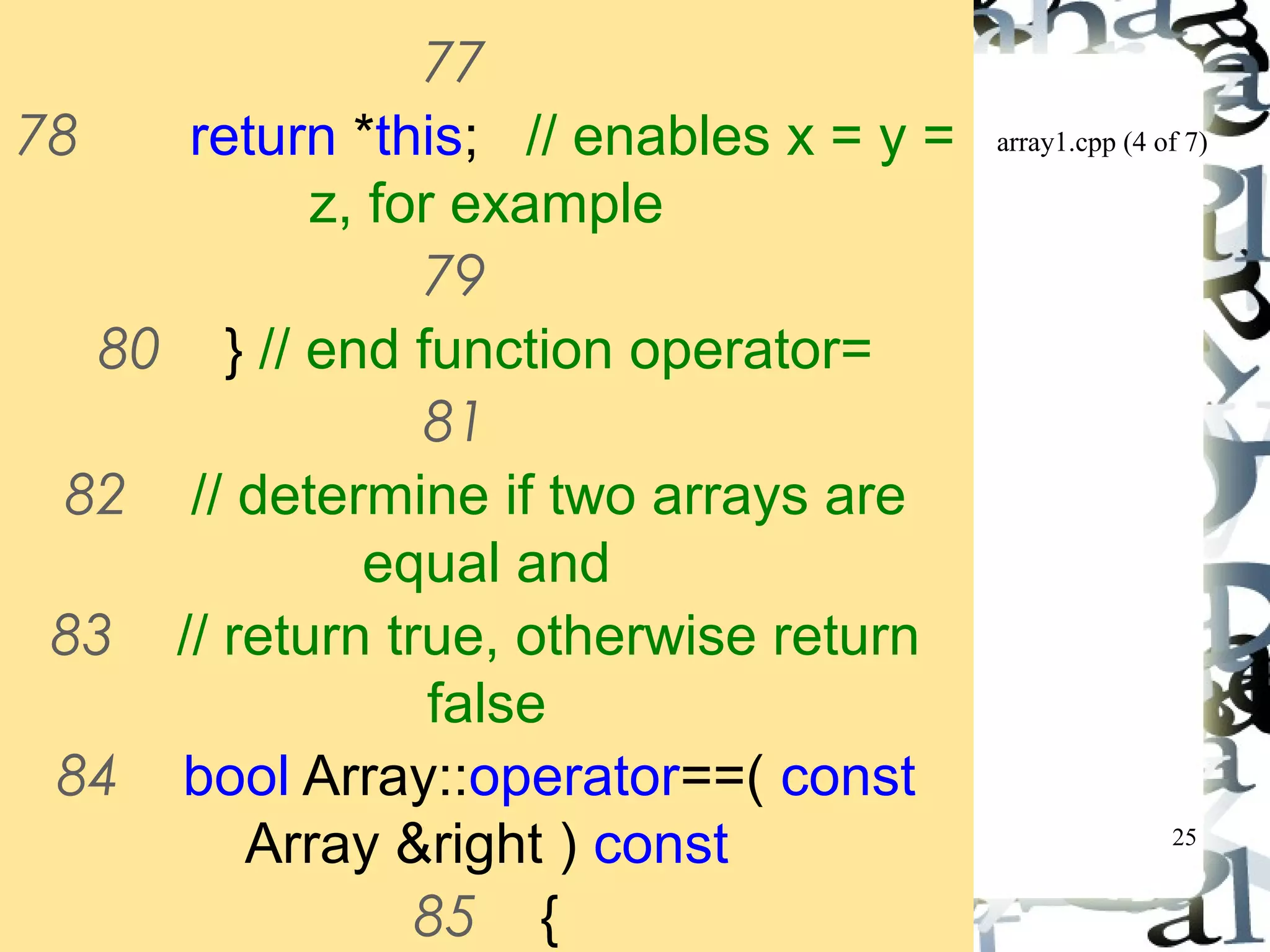
![array1.cpp (5 of 7)
26
98 // overloaded subscript operator
for non-const Arrays
99 // reference return creates an
lvalue
integers1[5] calls
integers1.operator[]( 5 )
100 int &Array::operator[]( int
exit() (header <cstdlib>) ends
the program.
subscript )
101 {
102 // check for subscript out of
range error
103 if ( subscript < 0 || subscript >=
size ) {
104 cout << "nError: Subscript "
<< subscript
105 << " out of range" <<](https://image.slidesharecdn.com/synapseindiacomplainsharinginfoonchapter8-operatoroverloading-141101045042-conversion-gate02/75/Synapse-india-complain-sharing-info-on-chapter-8-operator-overloading-26-2048.jpg)
 const
118 {
119 // check for subscript out of
range error
120 if ( subscript < 0 || subscript >=
size ) {
121 cout << "nError: Subscript "
<< subscript
122 << " out of range" <<](https://image.slidesharecdn.com/synapseindiacomplainsharinginfoonchapter8-operatoroverloading-141101045042-conversion-gate02/75/Synapse-india-complain-sharing-info-on-chapter-8-operator-overloading-27-2048.jpg)
![array1.cpp (7 of 7)
28
142
143 // overloaded output operator for
class Array
144 ostream &operator<<( ostream
&output, const Array &a )
145 {
146 int i;
147
148 // output private ptr-based
array
149 for ( i = 0; i < a.size; i++ ) {
150 output << setw( 12 ) << a.ptr[
i ];
151](https://image.slidesharecdn.com/synapseindiacomplainsharinginfoonchapter8-operatoroverloading-141101045042-conversion-gate02/75/Synapse-india-complain-sharing-info-on-chapter-8-operator-overloading-28-2048.jpg)
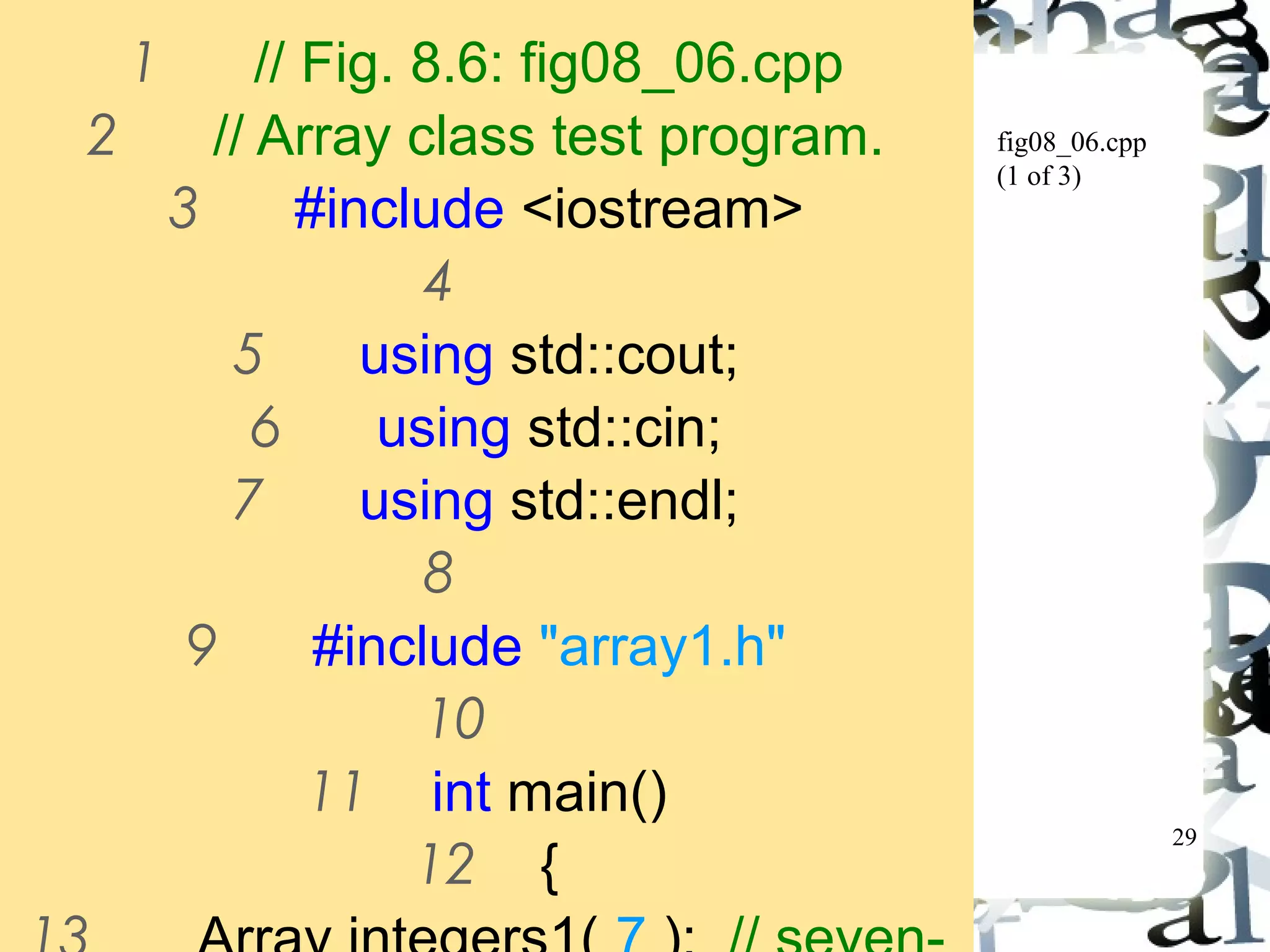




![34
fig08_06.cpp
output (3 of 3)
Assigning 1000 to integers1[5]
integers1:
8 9 10 11
12 1000 14 15
16 17
Attempt to assign 1000 to
integers1[15]
Error: Subscript 15 out of range](https://image.slidesharecdn.com/synapseindiacomplainsharinginfoonchapter8-operatoroverloading-141101045042-conversion-gate02/75/Synapse-india-complain-sharing-info-on-chapter-8-operator-overloading-34-2048.jpg)
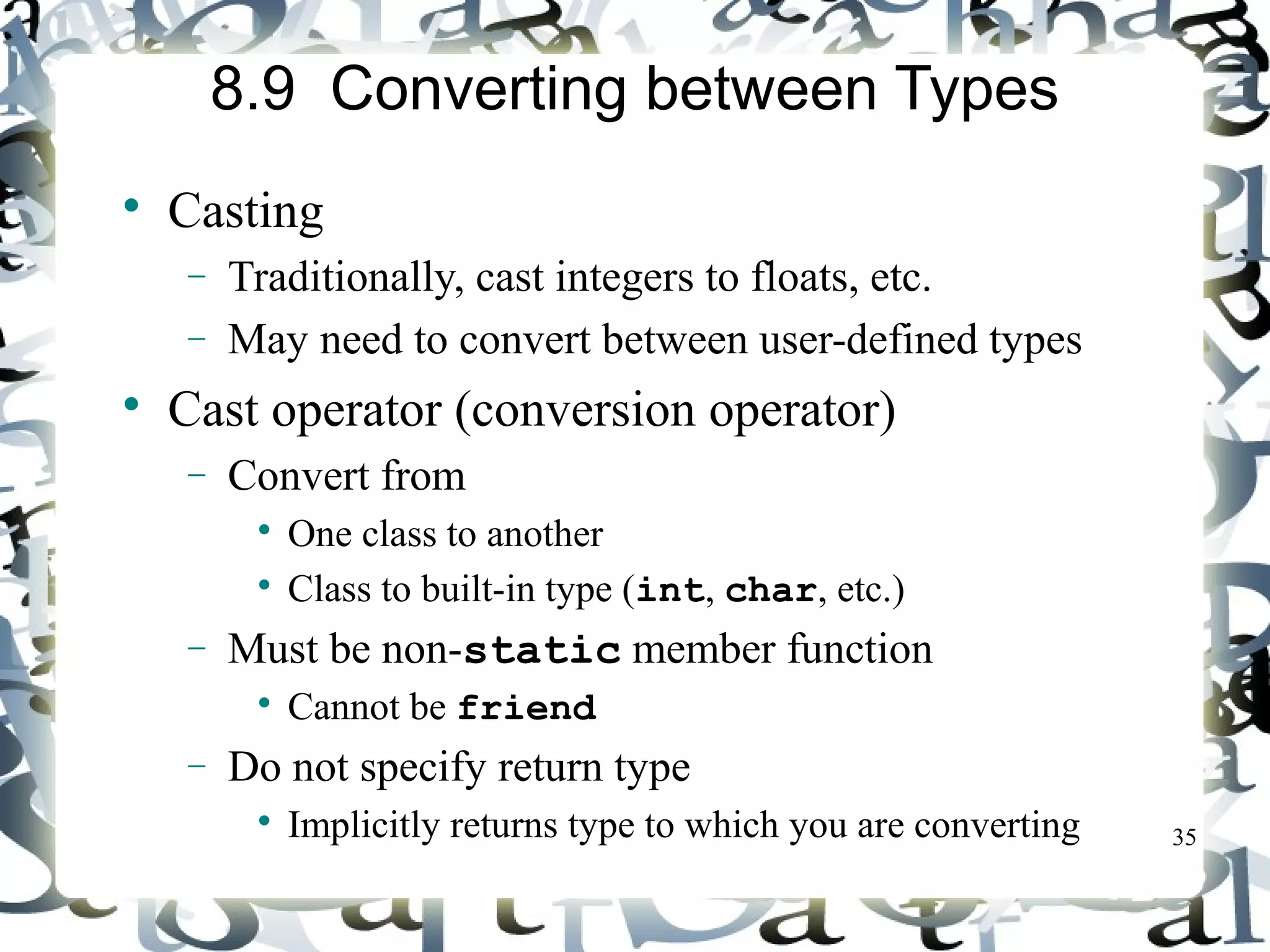
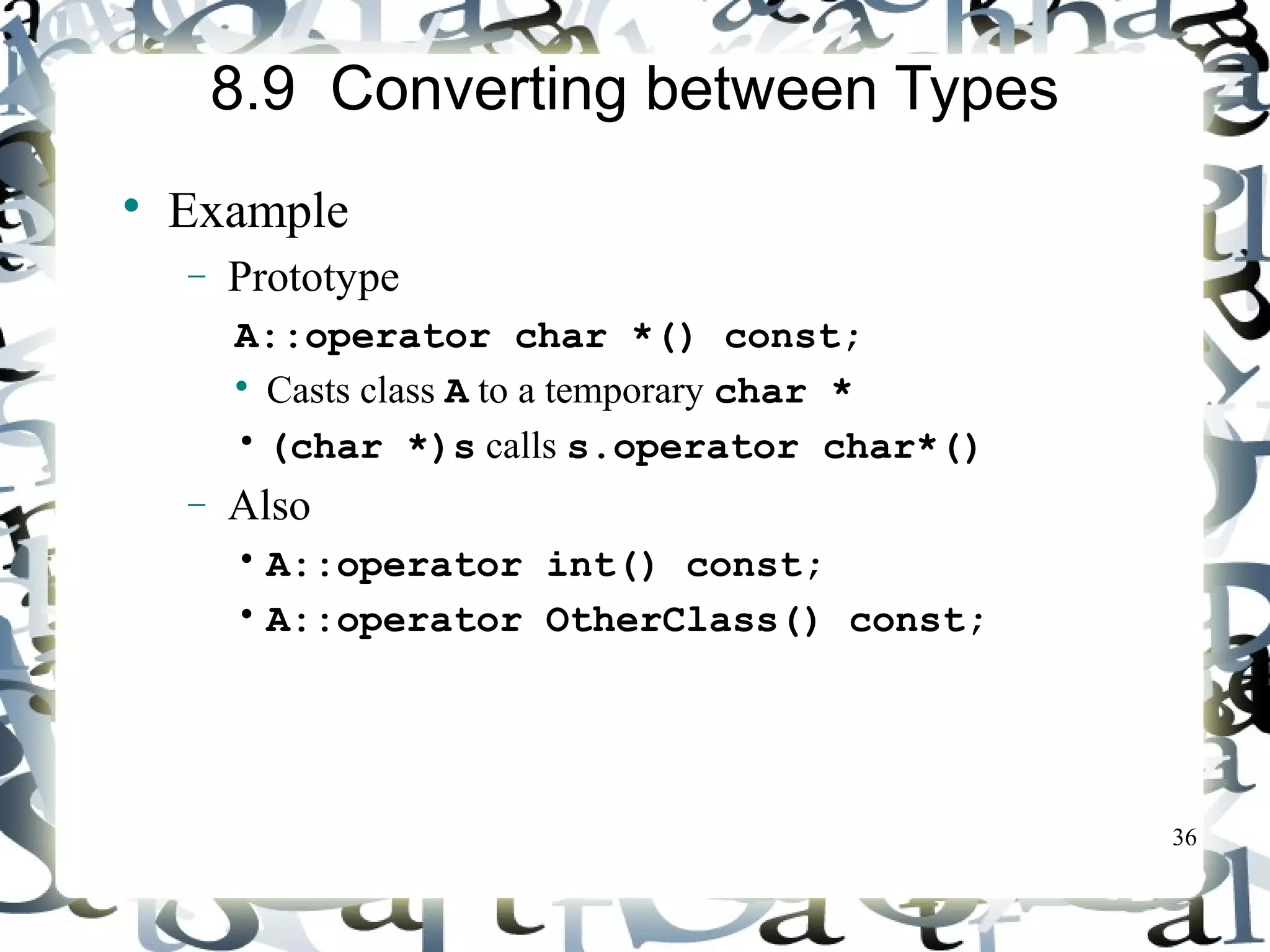
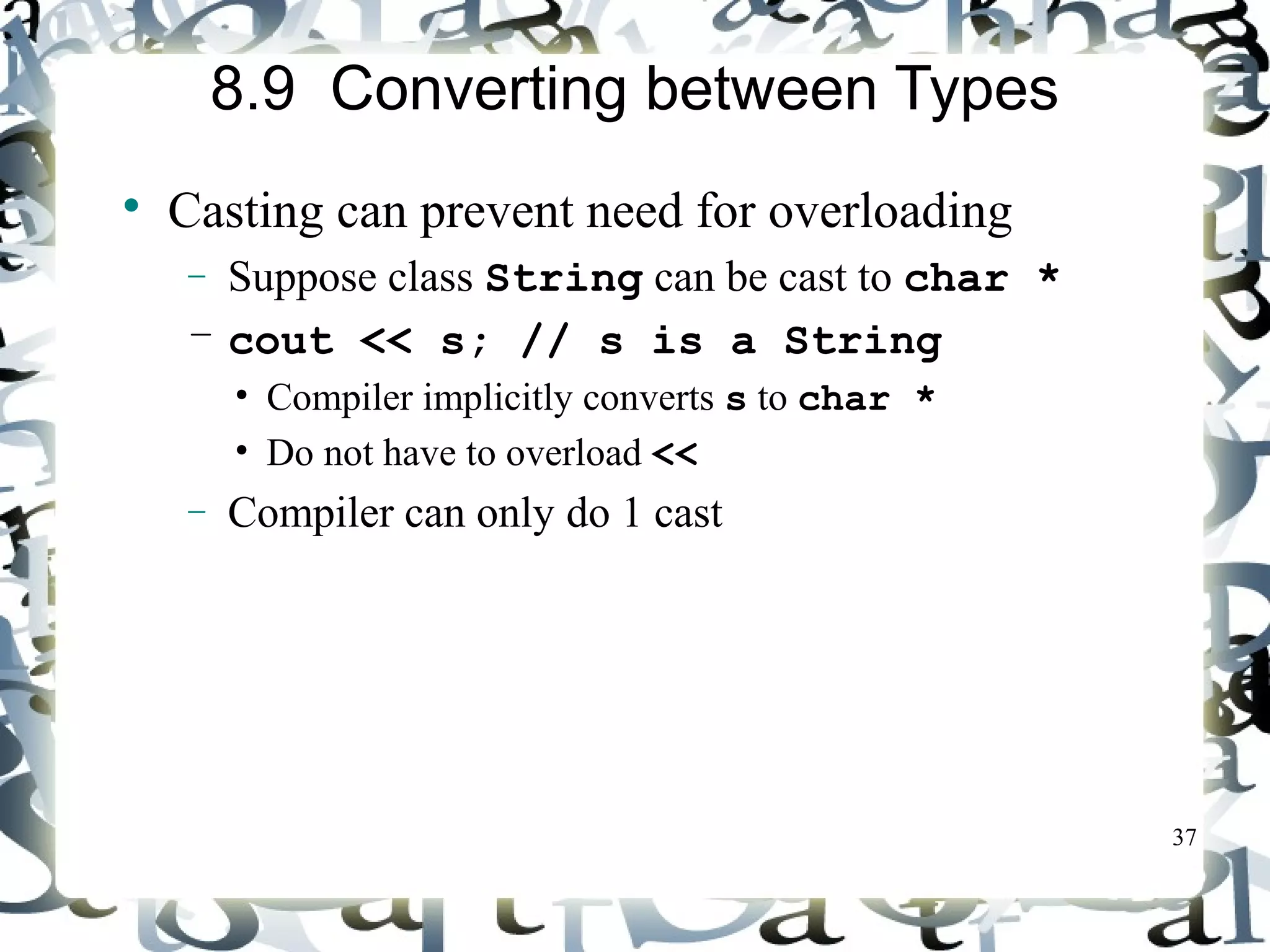
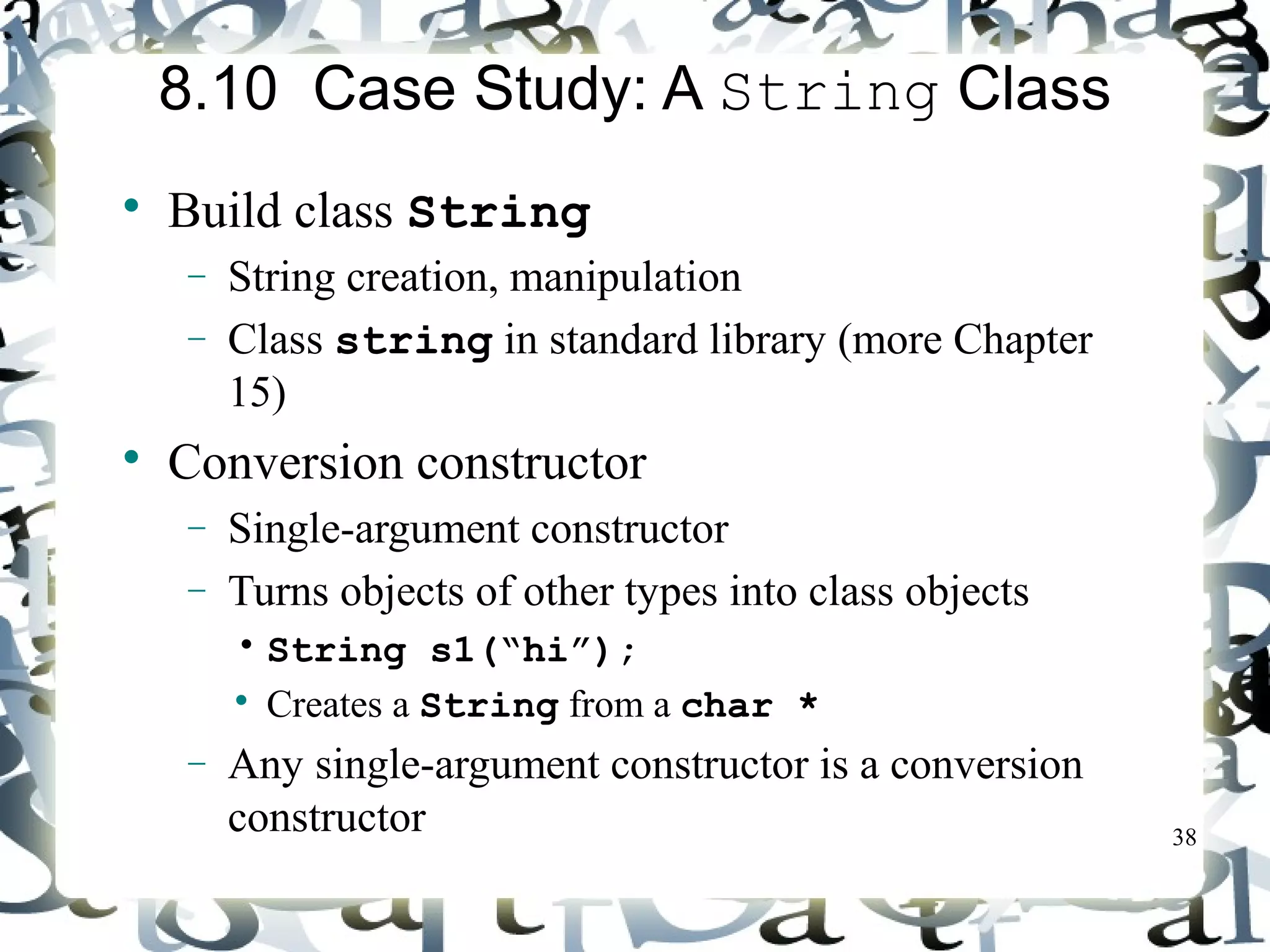
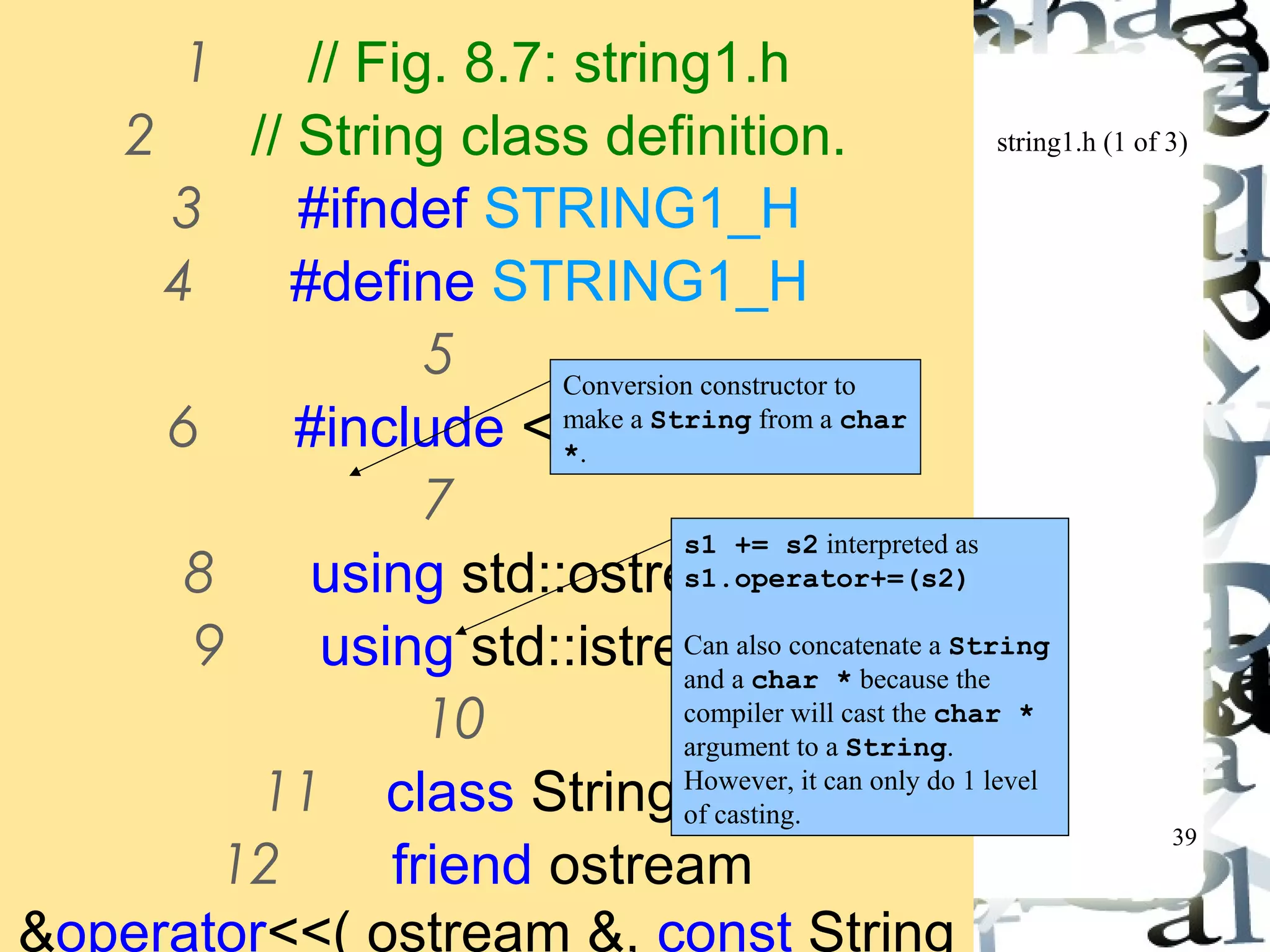
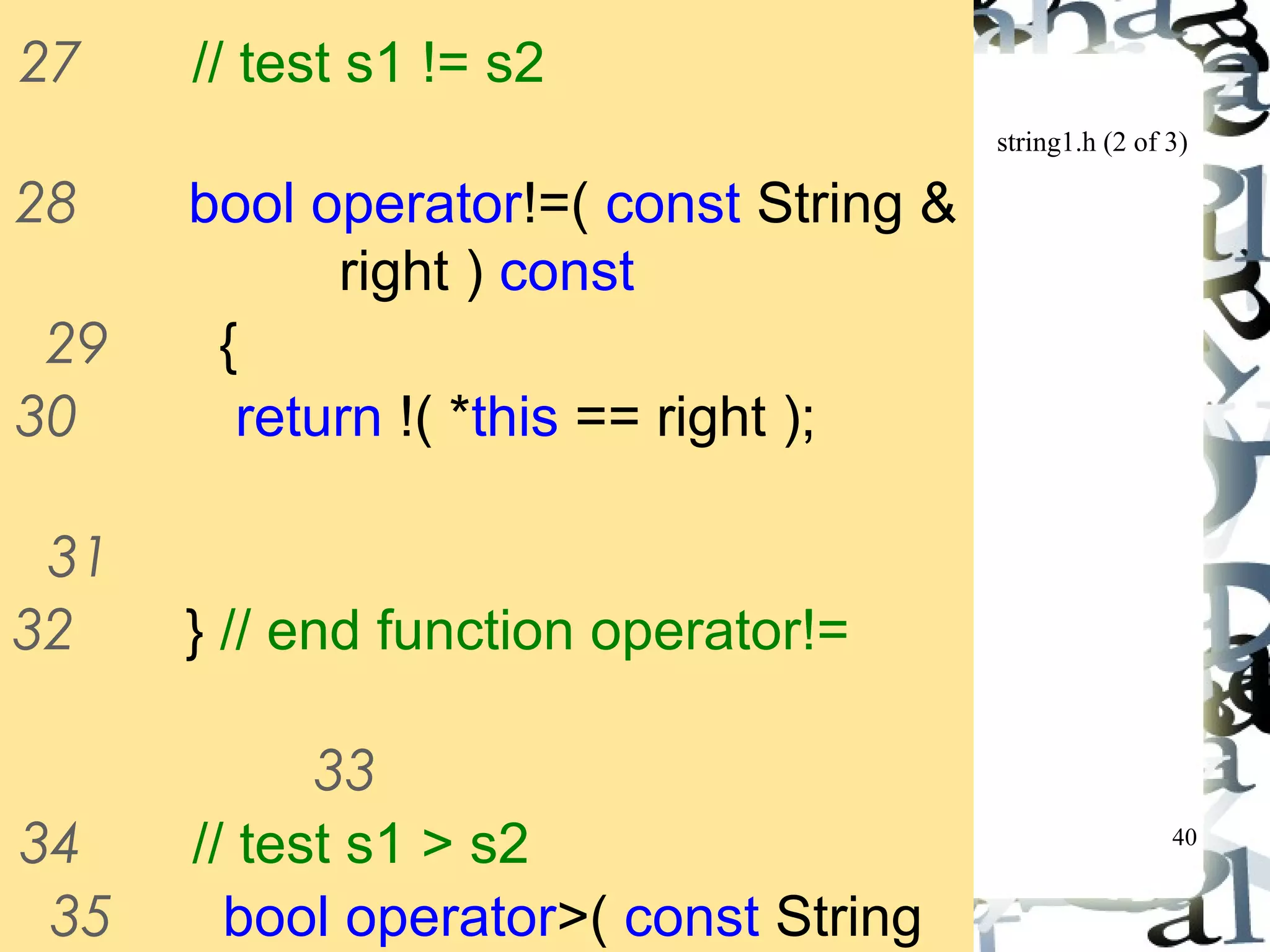
![string1.h (3 of 3)
41
54
Two overloaded subscript
operators, for const and
non-const objects.
55 char &operator[]
( int ); // subscript operator
56 const char &operator[]( int )
Overload the function call
operator () to return a
substring. This operator can
have any amount of operands.
const; // subscript operator
57
58 String operator()( int,
int ); // return a substring
59
60 int getLength()
const; // return string length
61
62 private:
63 int length; // string length](https://image.slidesharecdn.com/synapseindiacomplainsharinginfoonchapter8-operatoroverloading-141101045042-conversion-gate02/75/Synapse-india-complain-sharing-info-on-chapter-8-operator-overloading-41-2048.jpg)
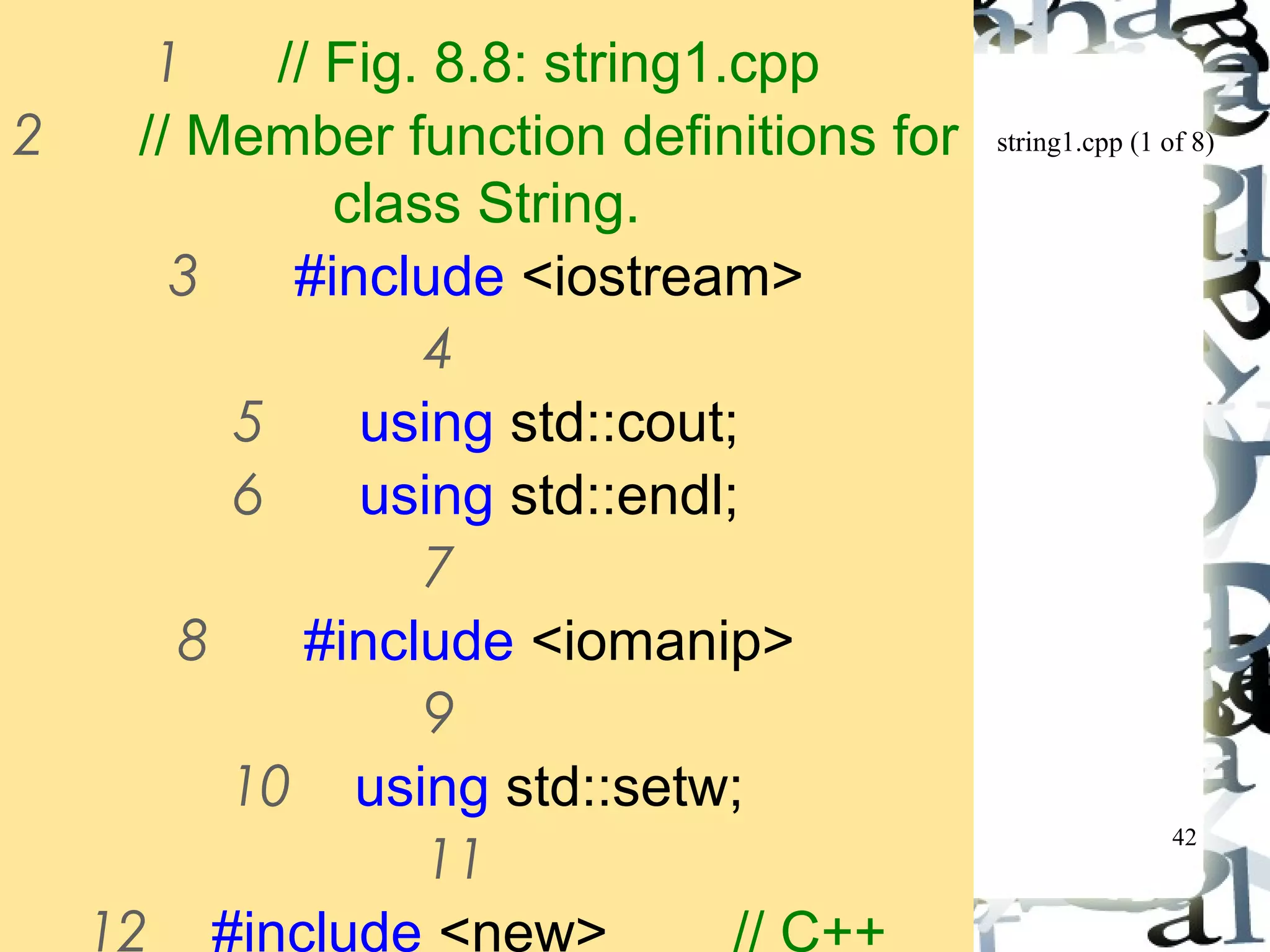
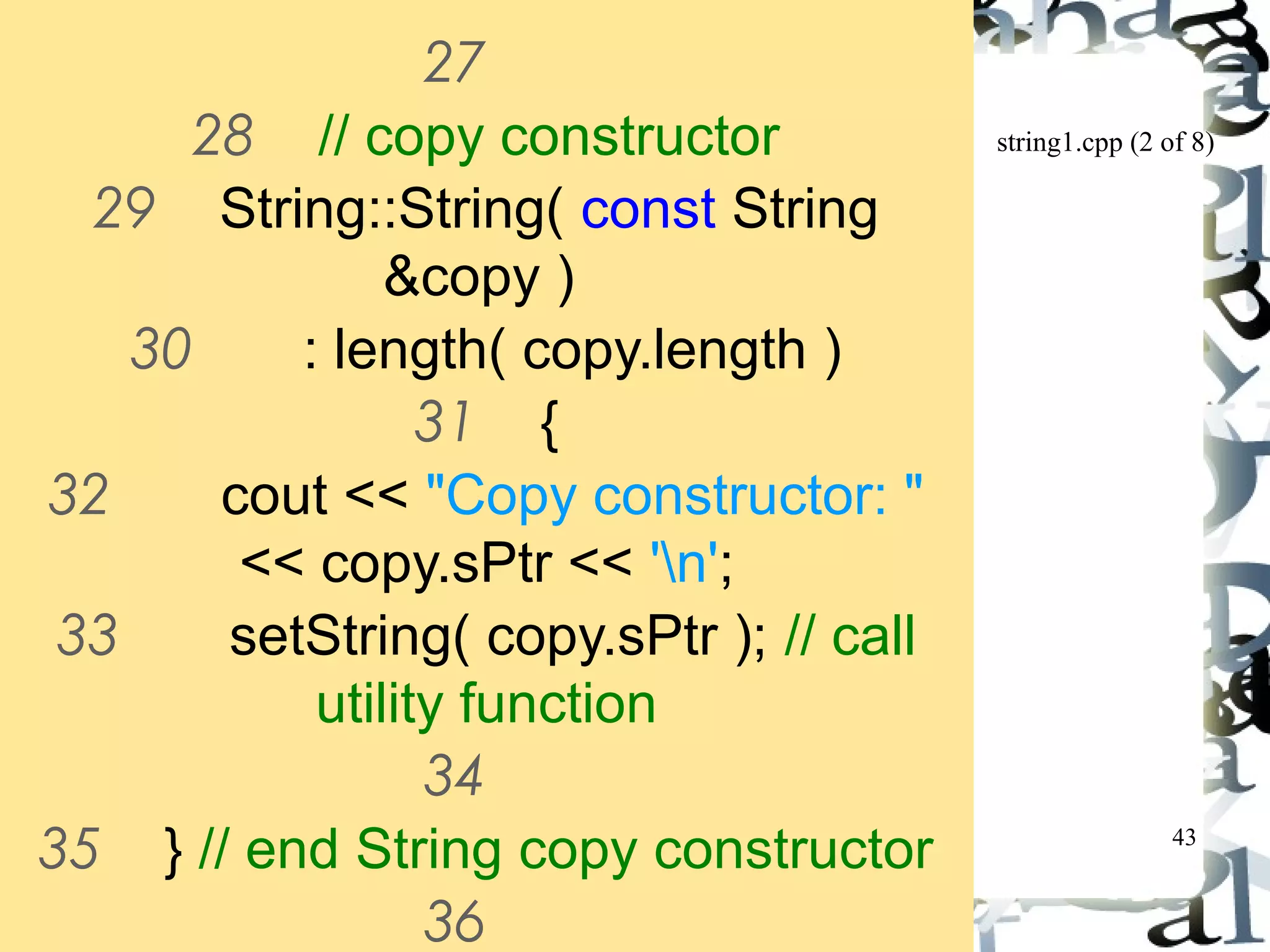

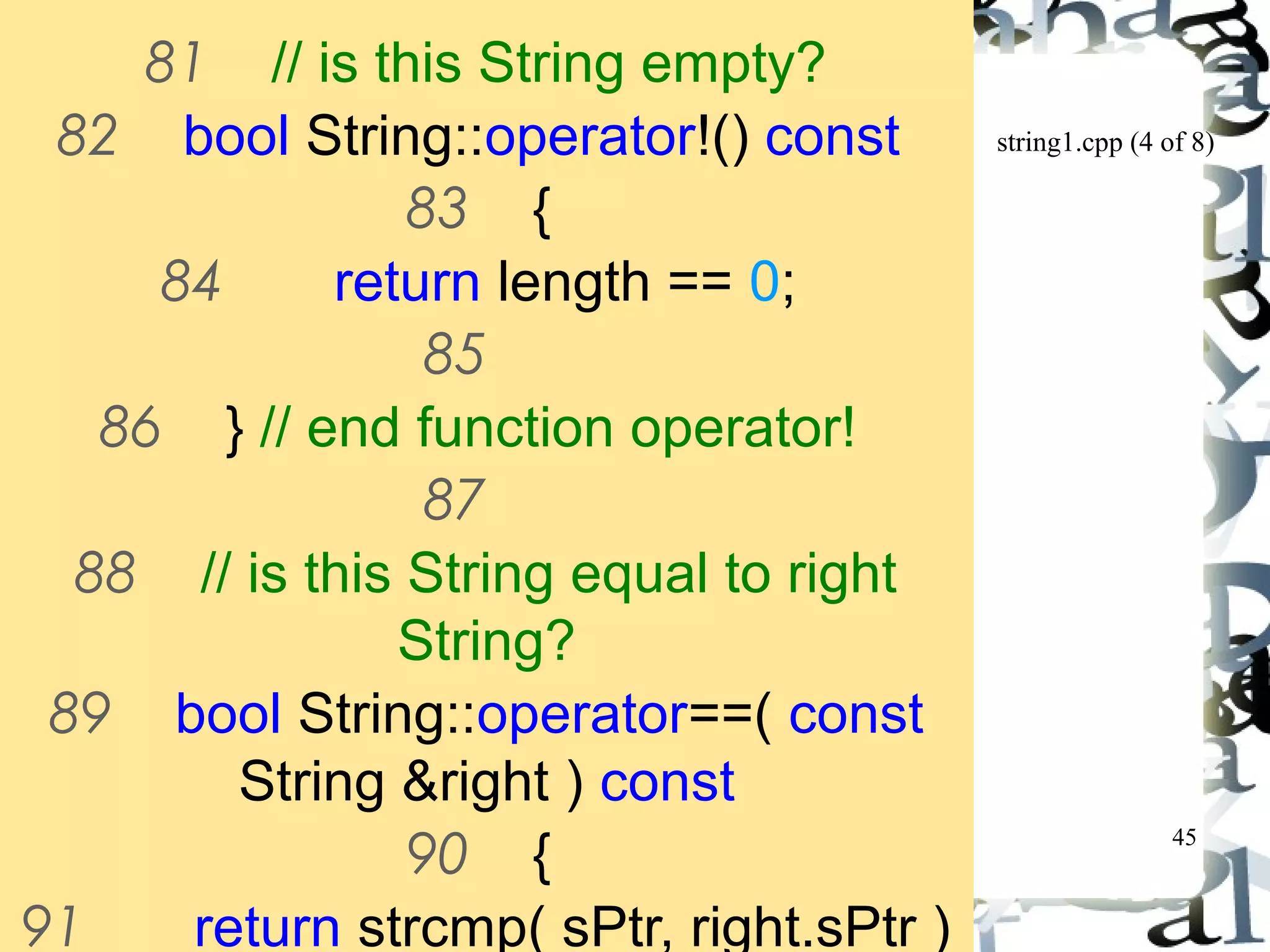

104 {
105 // test for subscript out of
range
106 if ( subscript < 0 || subscript >=
length ) {
107 cout << "Error: Subscript "
<< subscript
108 << " out of range" <<
endl;
109](https://image.slidesharecdn.com/synapseindiacomplainsharinginfoonchapter8-operatoroverloading-141101045042-conversion-gate02/75/Synapse-india-complain-sharing-info-on-chapter-8-operator-overloading-46-2048.jpg)
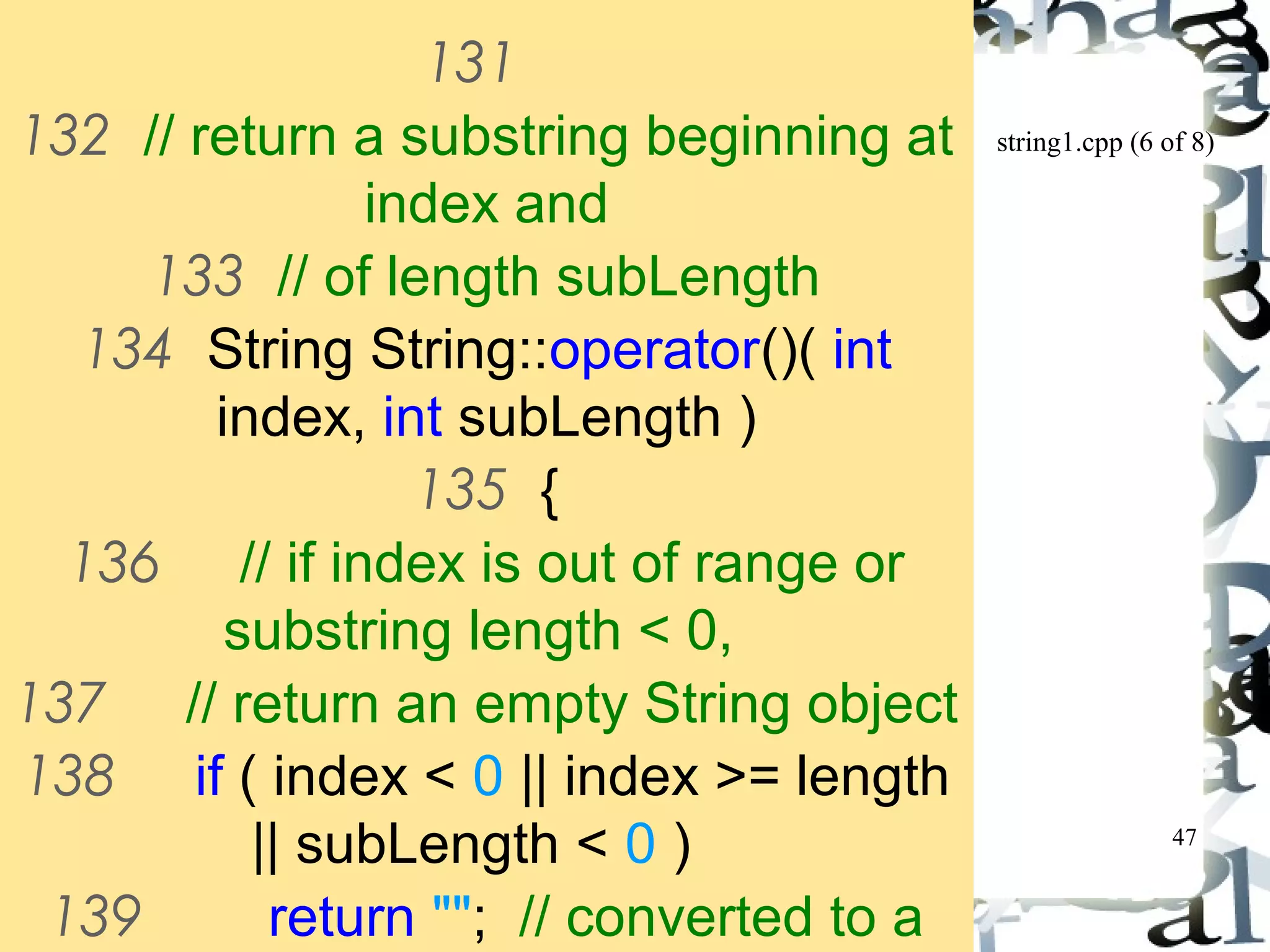
![string1.cpp (7 of 8)
48
156
157 // create temporary String
object containing the substring
158 String tempString( tempPtr );
159 delete [] tempPtr; // delete
temporary array
160
161 return tempString; // return
copy of the temporary String
162
163 } // end function operator()
164
165 // return string length](https://image.slidesharecdn.com/synapseindiacomplainsharinginfoonchapter8-operatoroverloading-141101045042-conversion-gate02/75/Synapse-india-complain-sharing-info-on-chapter-8-operator-overloading-48-2048.jpg)
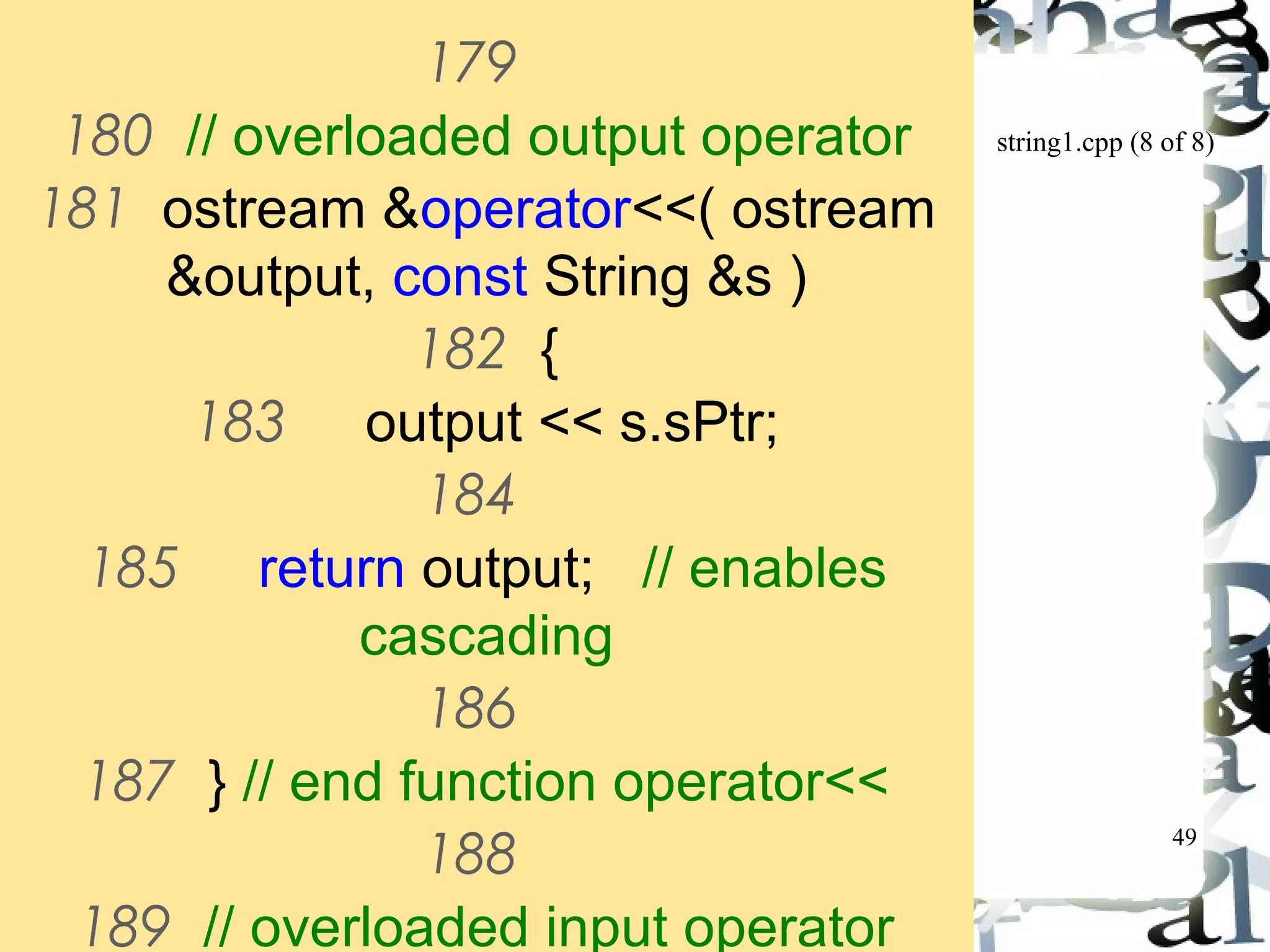
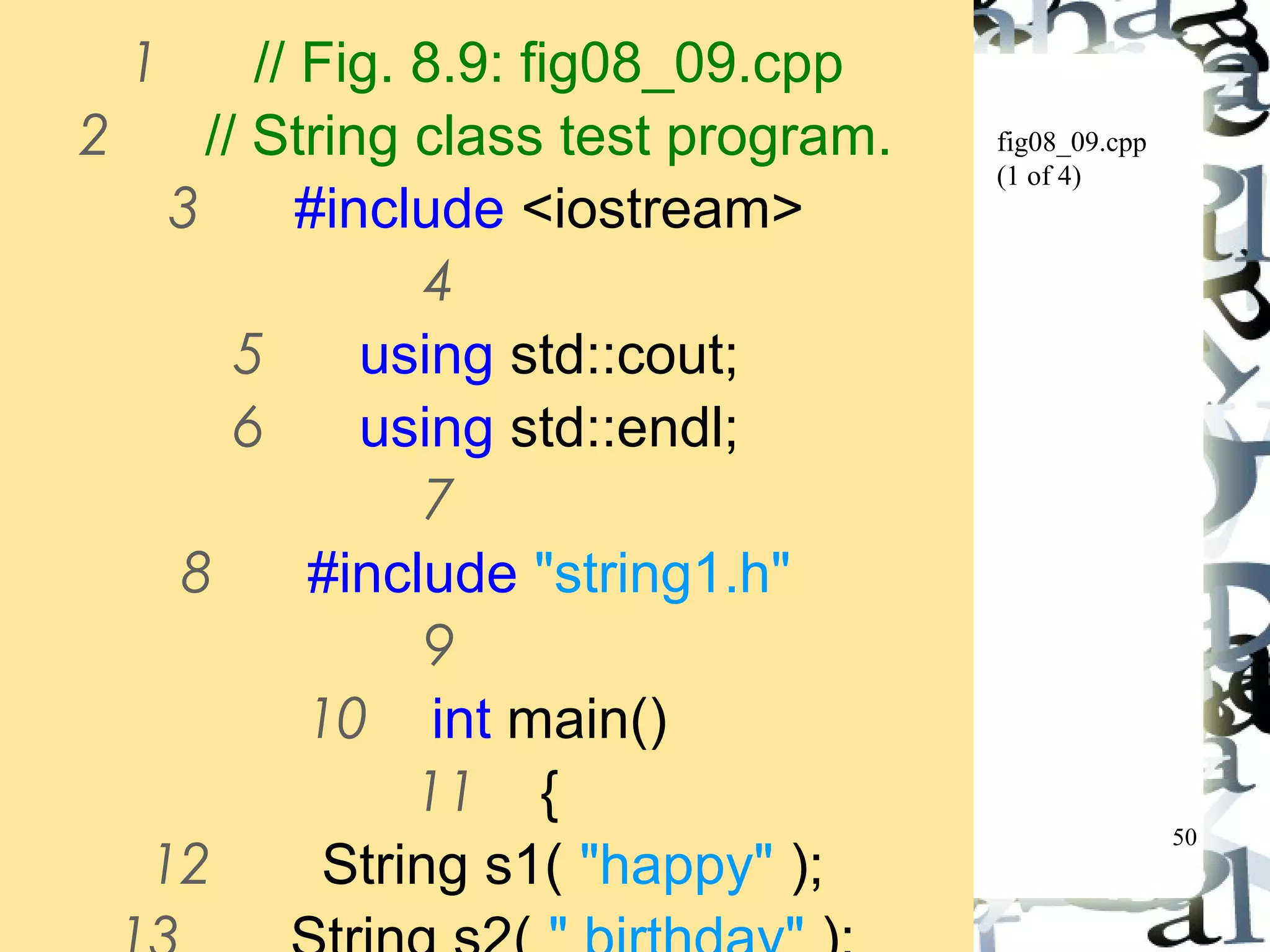
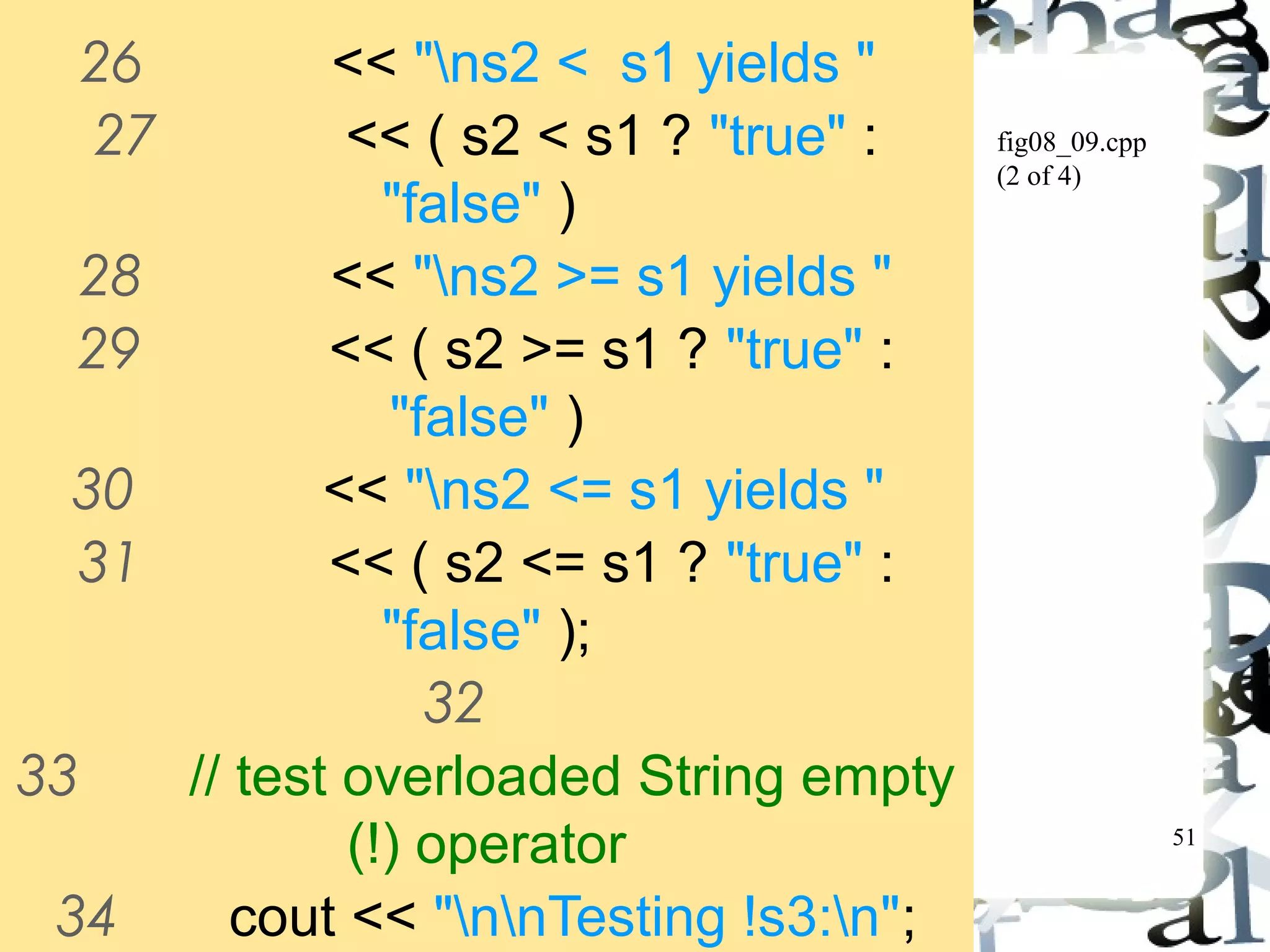
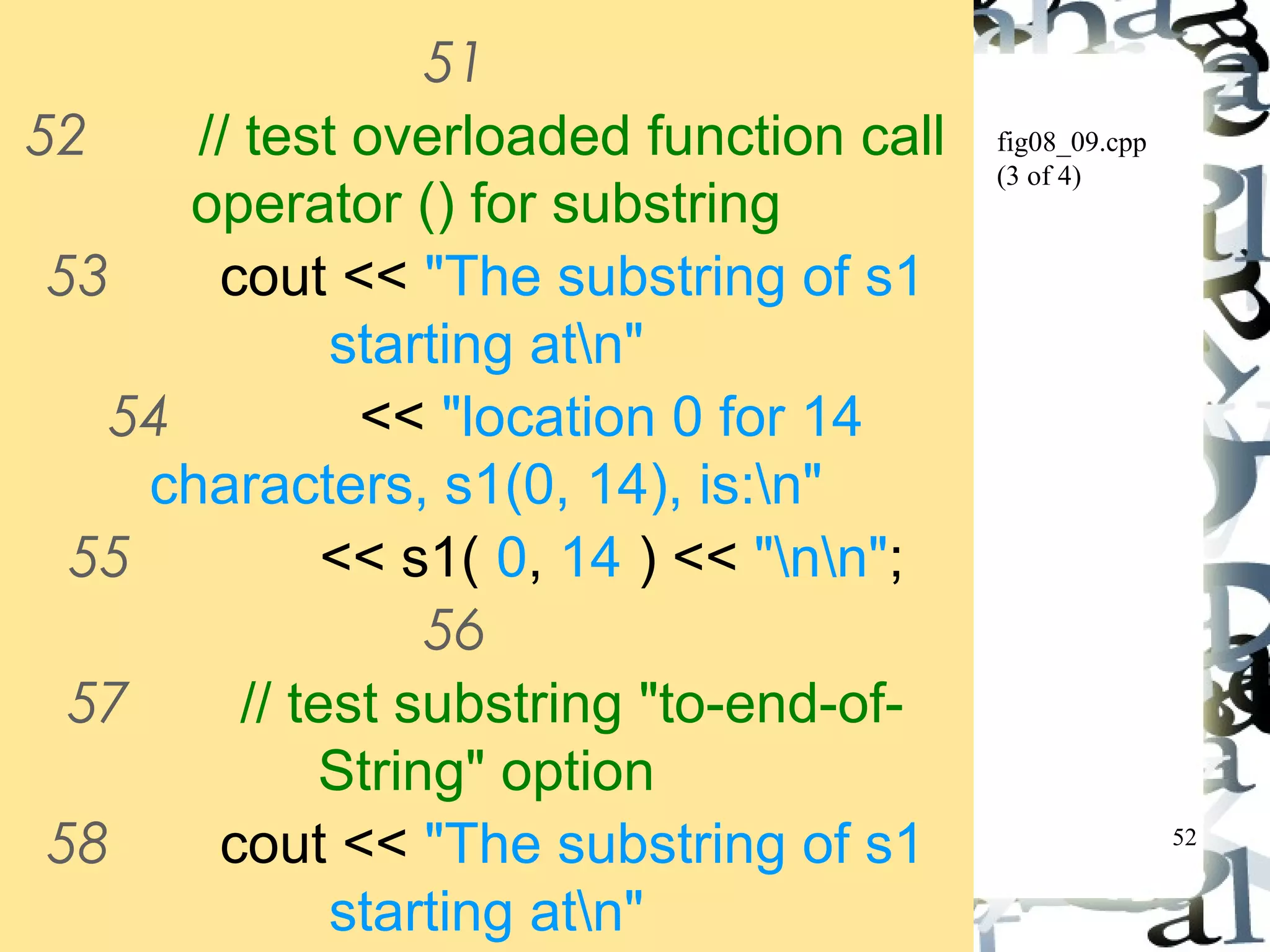
![53
fig08_09.cpp
(4 of 4)
74 // test using subscript operator
to create lvalue
75 s1[ 0 ] = 'H';
76 s1[ 6 ] = 'B';
77 cout << "ns1 after s1[0] = 'H'
and s1[6] = 'B' is: "
78 << s1 << "nn";
79
80 // test subscript out of range
81 cout << "Attempt to assign 'd'](https://image.slidesharecdn.com/synapseindiacomplainsharinginfoonchapter8-operatoroverloading-141101045042-conversion-gate02/75/Synapse-india-complain-sharing-info-on-chapter-8-operator-overloading-53-2048.jpg)
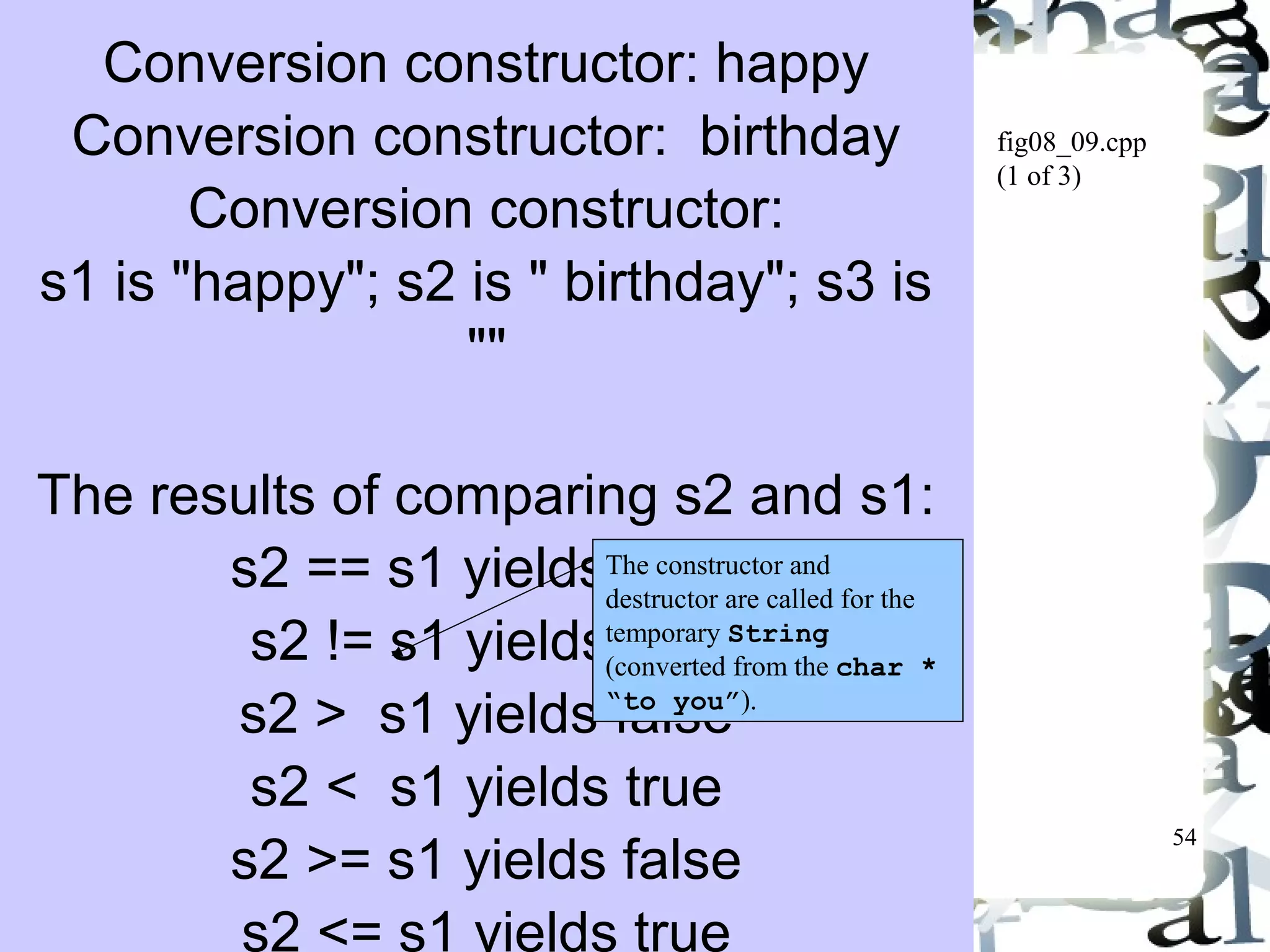
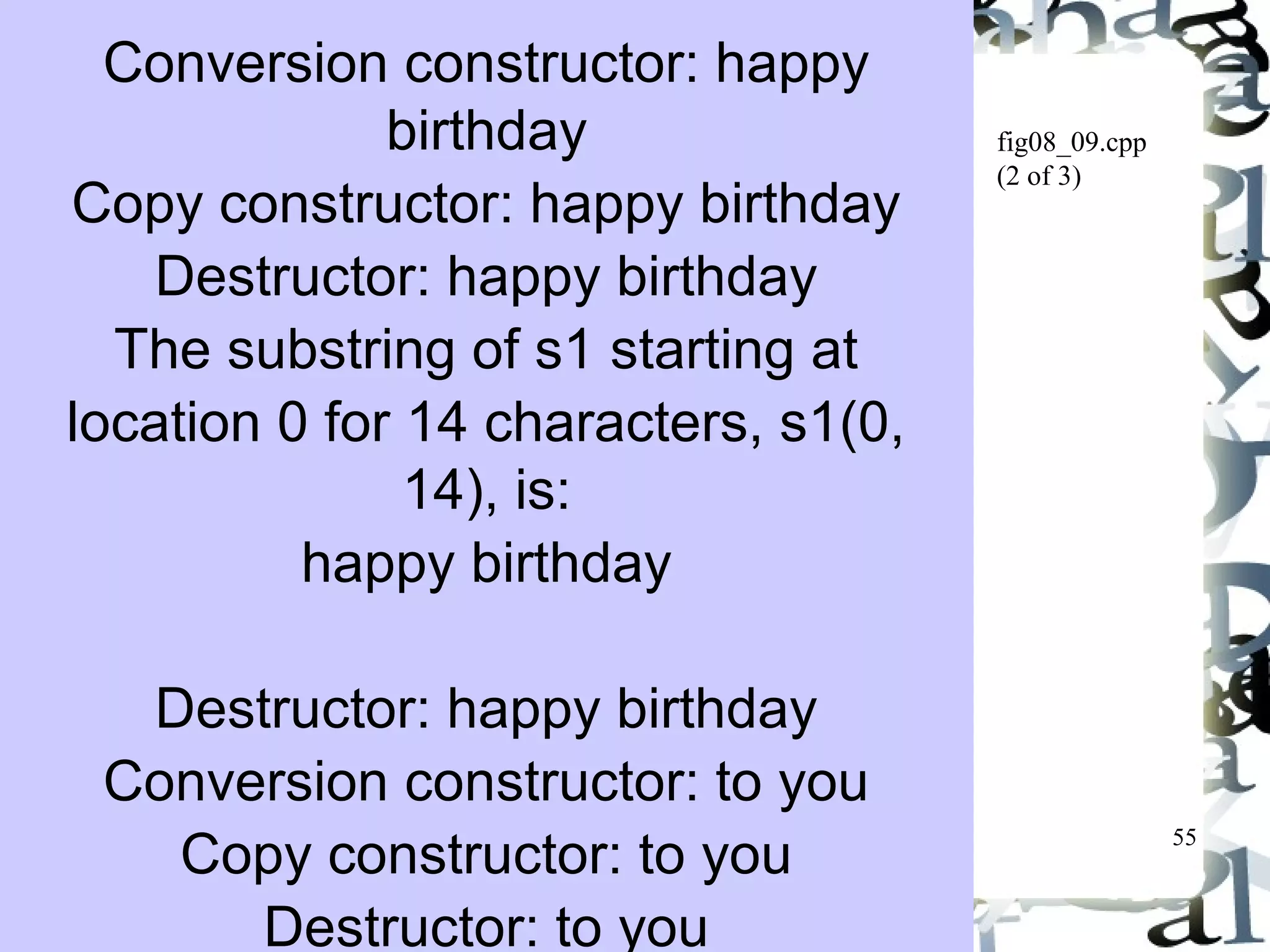
![56
fig08_09.cpp
(3 of 3)
s1 after s1[0] = 'H' and s1[6] = 'B' is:
Happy Birthday to you
Attempt to assign 'd' to s1[30] yields:
Error: Subscript 30 out of range](https://image.slidesharecdn.com/synapseindiacomplainsharinginfoonchapter8-operatoroverloading-141101045042-conversion-gate02/75/Synapse-india-complain-sharing-info-on-chapter-8-operator-overloading-56-2048.jpg)
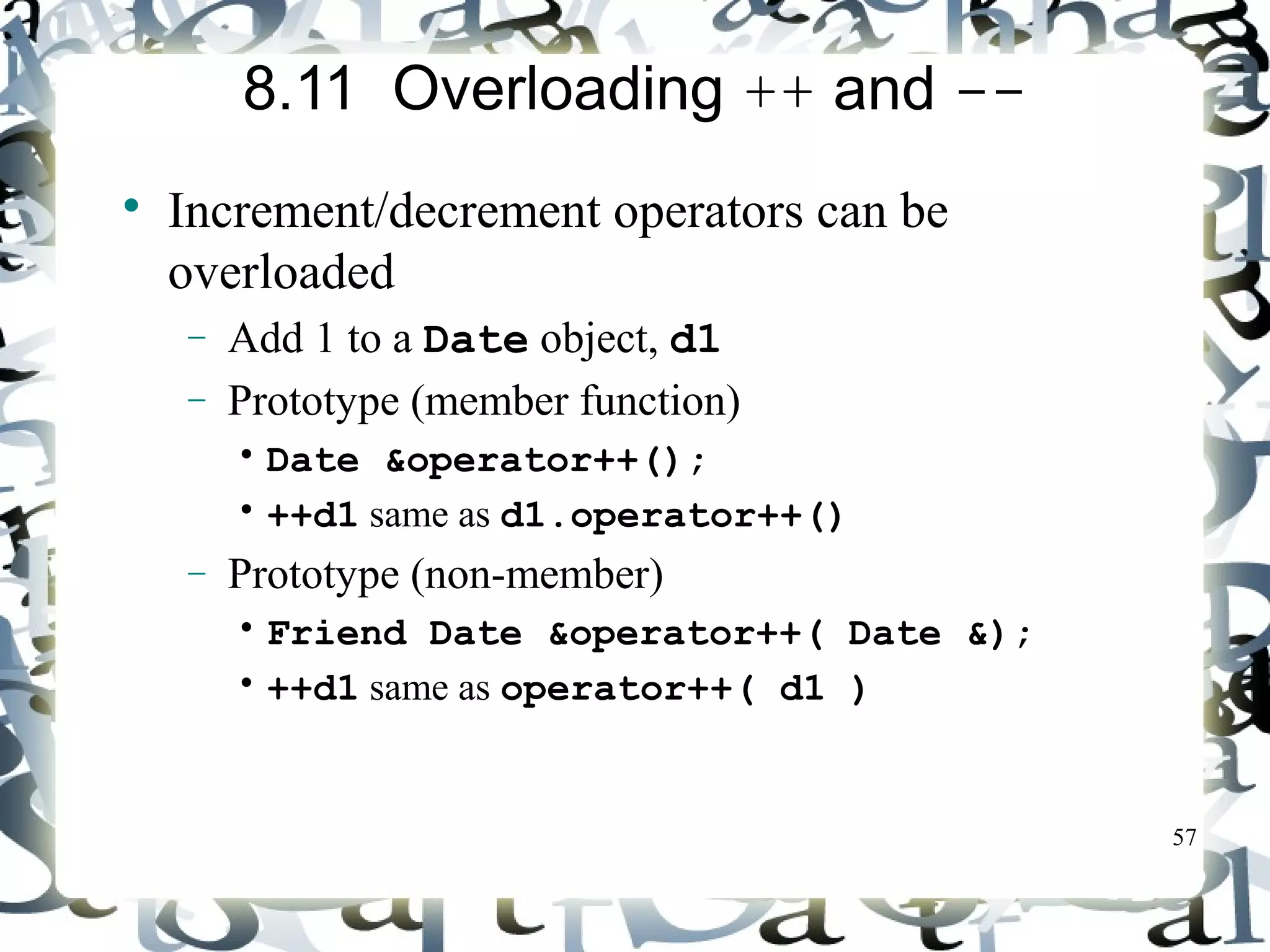
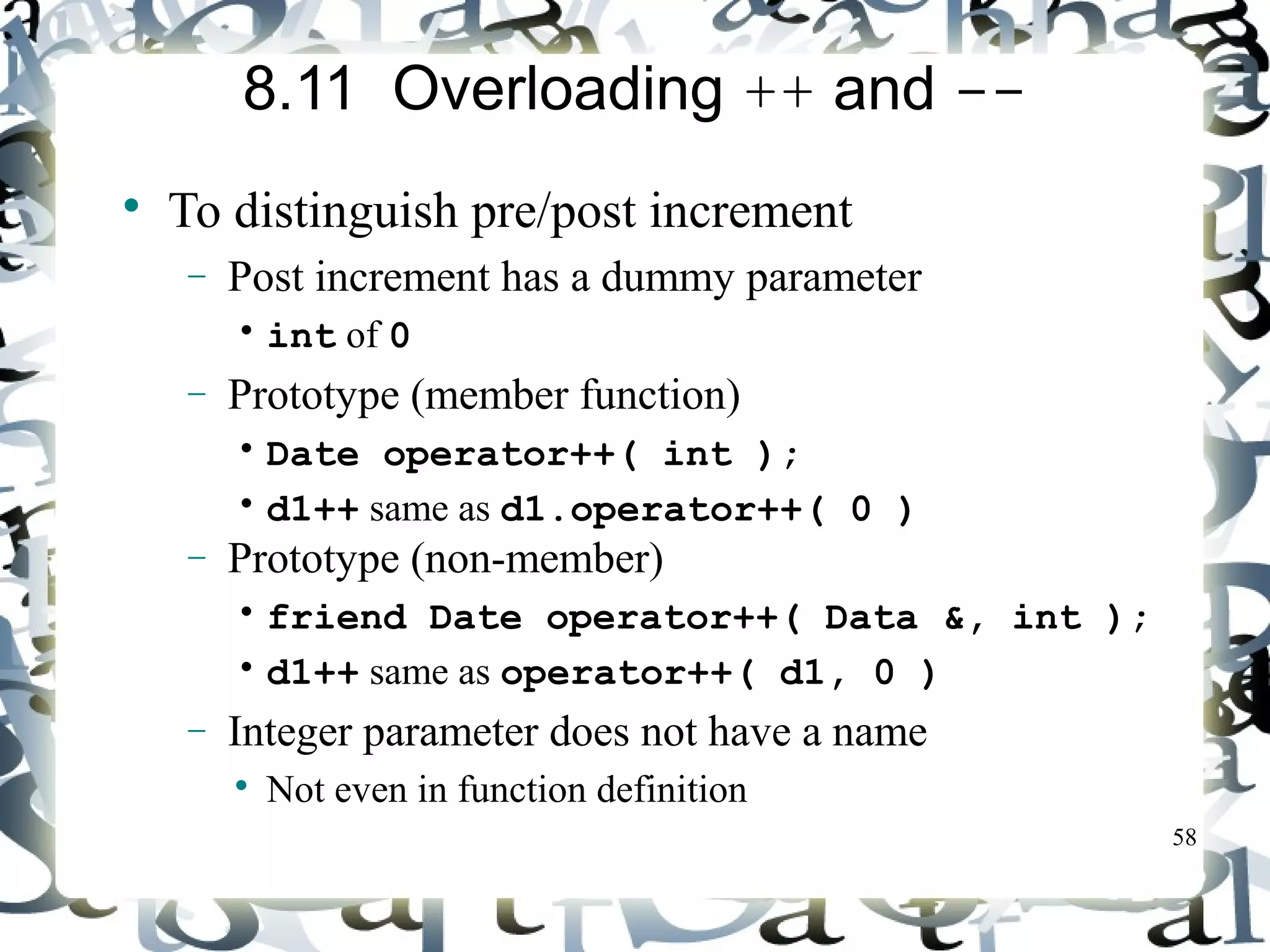

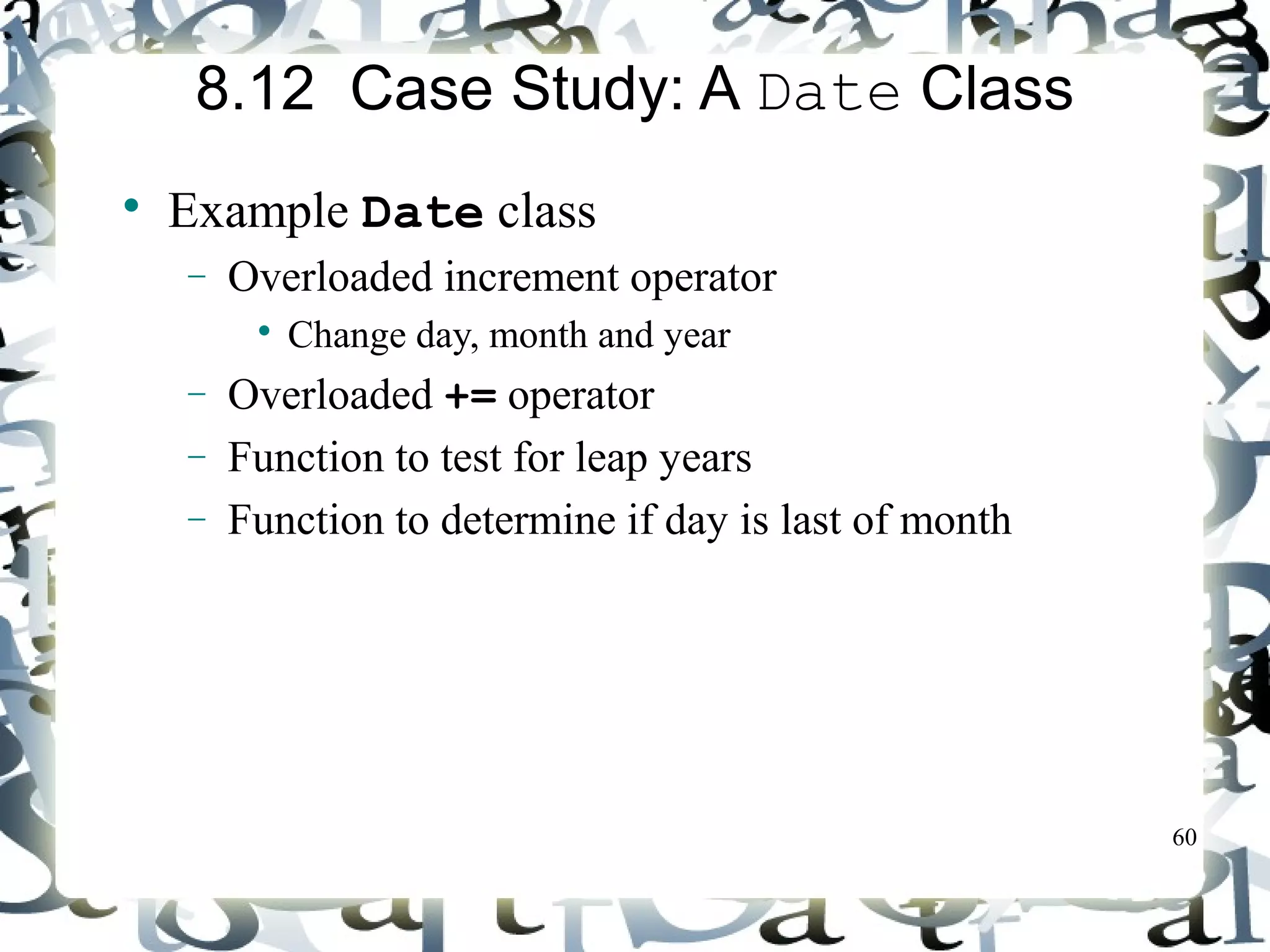
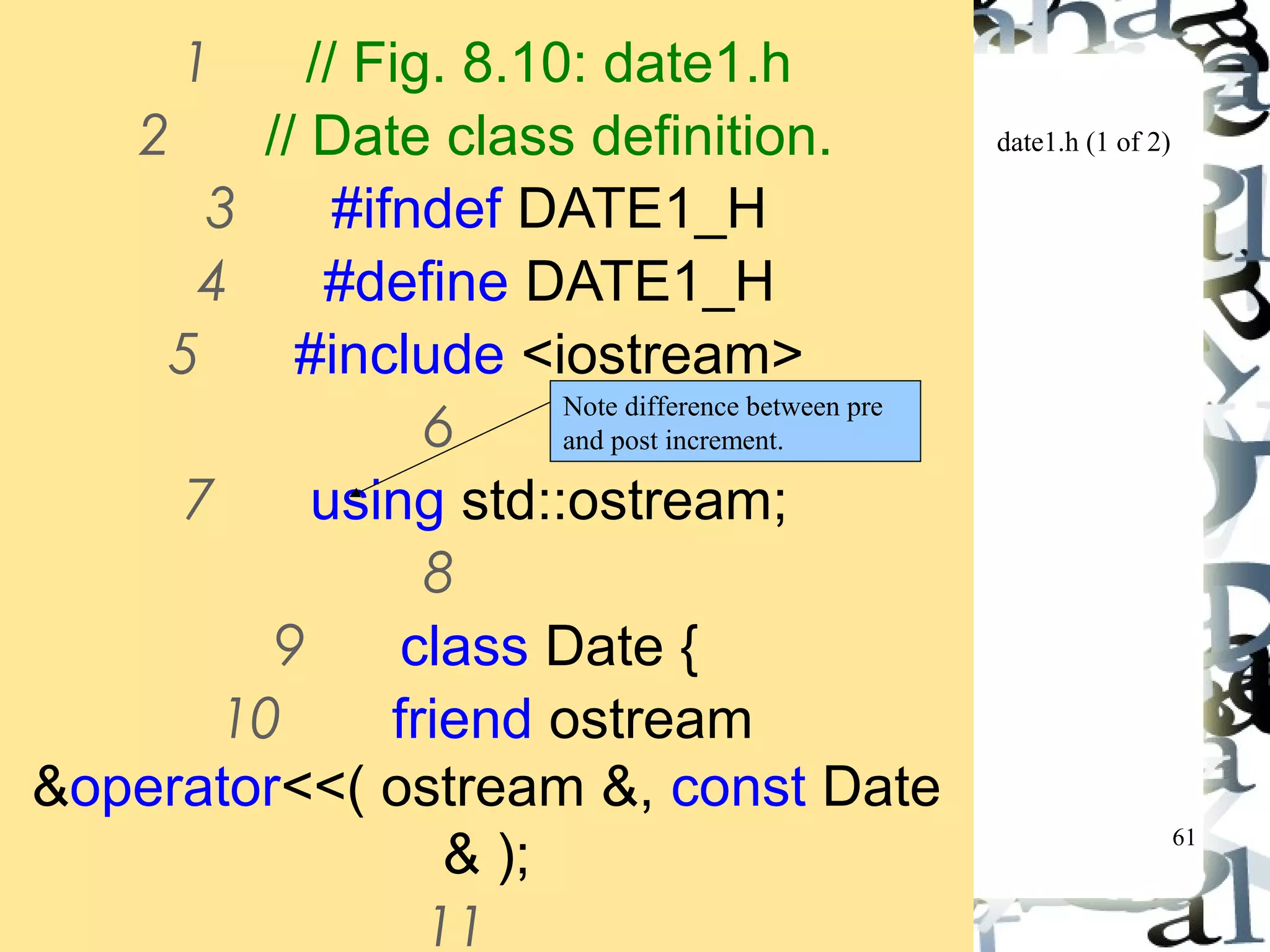
![62
date1.h (2 of 2)
23
24 private:
25 int month;
26 int day;
27 int year;
28
29 static const int days[]; //
array of days per month
30 void helpIncrement(); //
utility function
31
32 }; // end class Date
33](https://image.slidesharecdn.com/synapseindiacomplainsharinginfoonchapter8-operatoroverloading-141101045042-conversion-gate02/75/Synapse-india-complain-sharing-info-on-chapter-8-operator-overloading-62-2048.jpg)
![date1.cpp (1 of 5)
63
1 // Fig. 8.11: date1.cpp
2 // Date class member function
definitions.
3 #include <iostream>
4 #include "date1.h"
5
6 // initialize static member at file
scope;
7 // one class-wide copy
8 const int Date::days[] =
9 { 0, 31, 28, 31, 30, 31, 30, 31,
31, 30, 31, 30, 31 };
10](https://image.slidesharecdn.com/synapseindiacomplainsharinginfoonchapter8-operatoroverloading-141101045042-conversion-gate02/75/Synapse-india-complain-sharing-info-on-chapter-8-operator-overloading-63-2048.jpg)
![date1.cpp (2 of 5)
64
24 // test for a leap year
25 if ( month == 2 &&
leapYear( year ) )
26 day = ( dd >= 1 && dd <=
29 ) ? dd : 1;
27 else
28 day = ( dd >= 1 && dd <=
Postincrement updates object
and returns a copy of the
original. Do not return a
reference to temp, because it
is a local variable that will be
destroyed.
Also note that the integer
parameter does not have a
name.
days[ month ] ) ? dd : 1;
29
30 } // end function setDate
31
32 // overloaded preincrement
operator
33 Date &Date::operator++()](https://image.slidesharecdn.com/synapseindiacomplainsharinginfoonchapter8-operatoroverloading-141101045042-conversion-gate02/75/Synapse-india-complain-sharing-info-on-chapter-8-operator-overloading-64-2048.jpg)
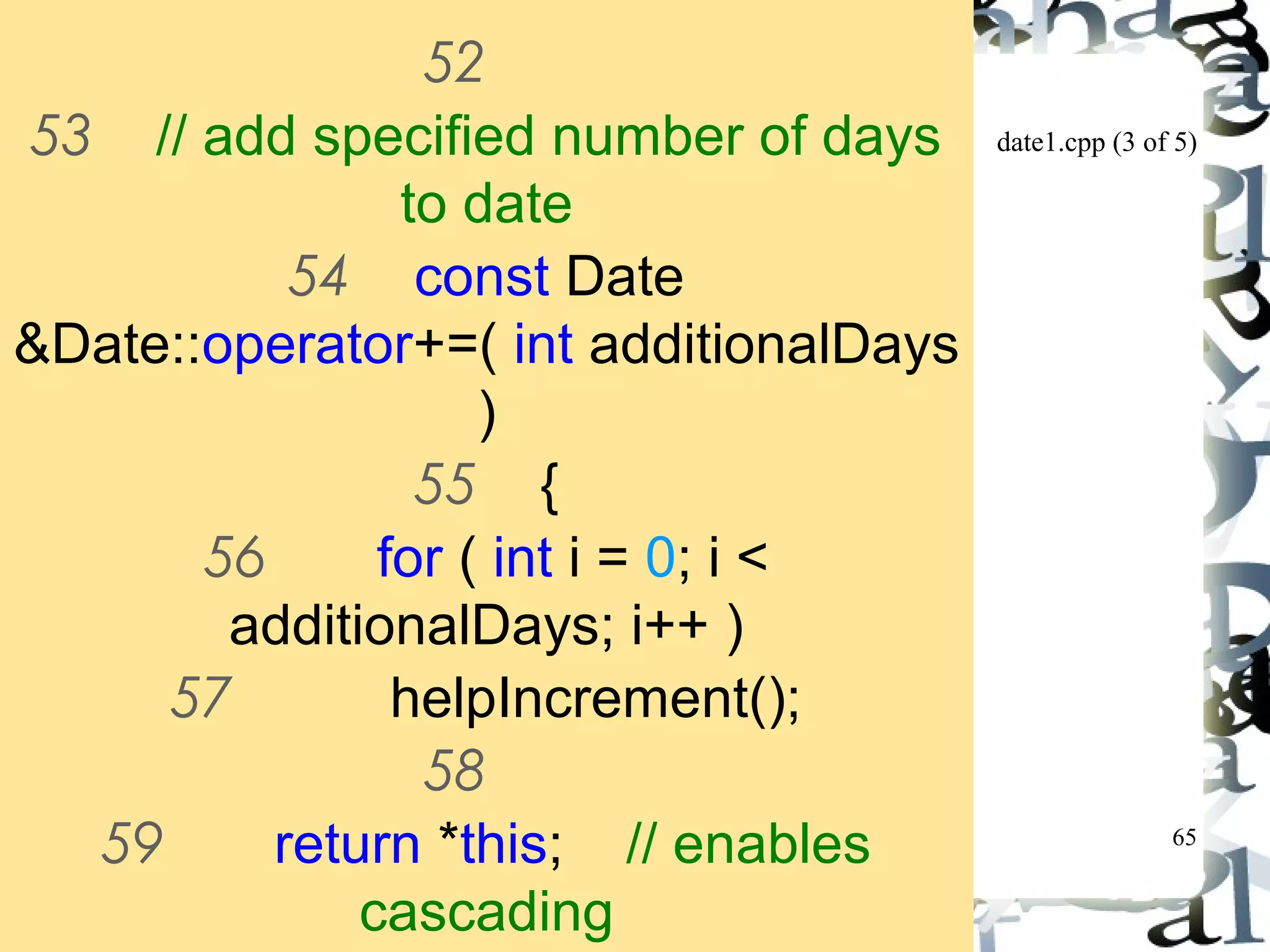
![date1.cpp (4 of 5)
66
75 // determine whether the day is
the last day of the month
76 bool Date::endOfMonth( int
testDay ) const
77 {
78 if ( month == 2 &&
leapYear( year ) )
79 return testDay == 29; // last
day of Feb. in leap year
80 else
81 return testDay ==
days[ month ];
82
83 } // end function endOfMonth](https://image.slidesharecdn.com/synapseindiacomplainsharinginfoonchapter8-operatoroverloading-141101045042-conversion-gate02/75/Synapse-india-complain-sharing-info-on-chapter-8-operator-overloading-66-2048.jpg)
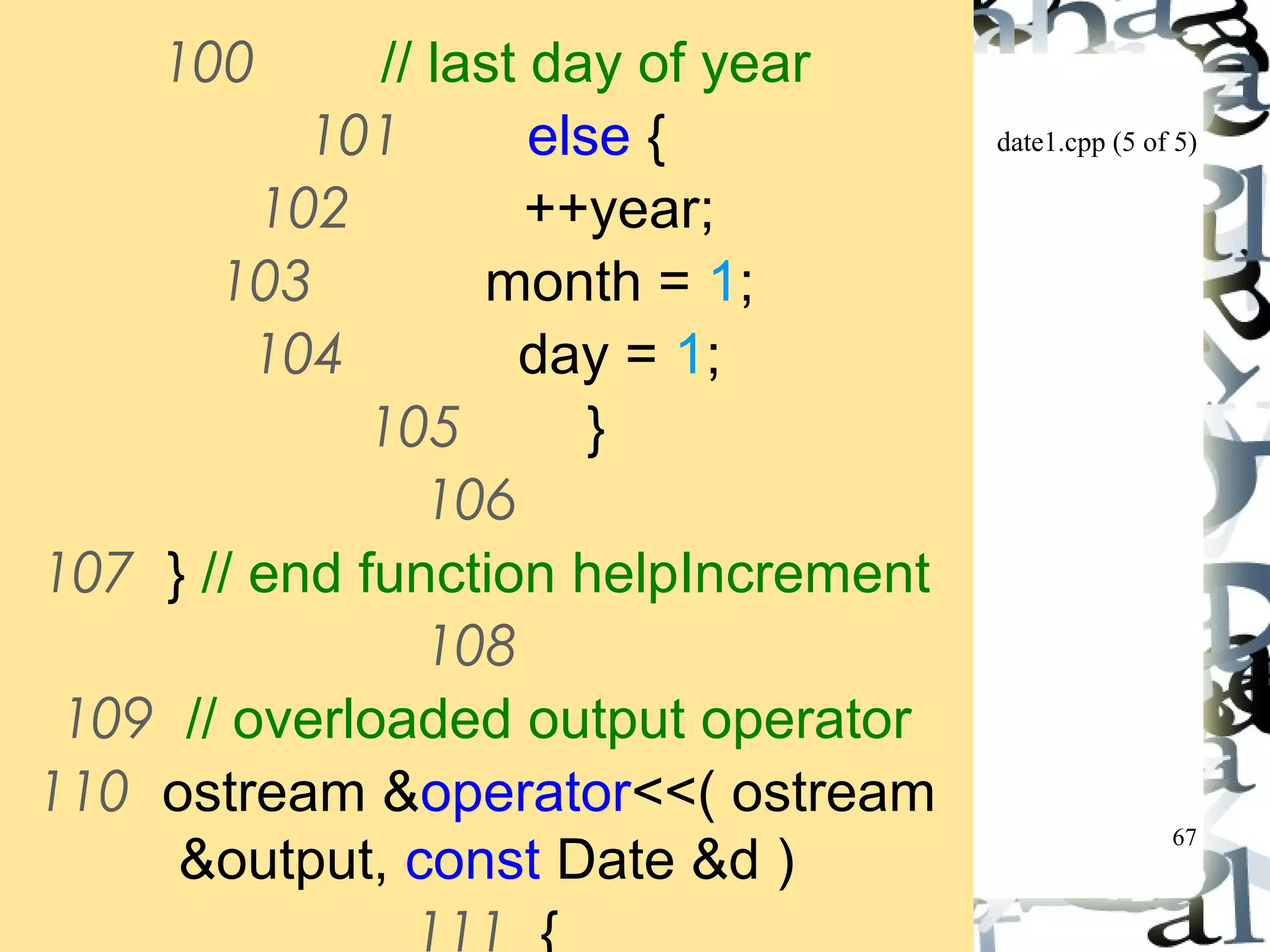
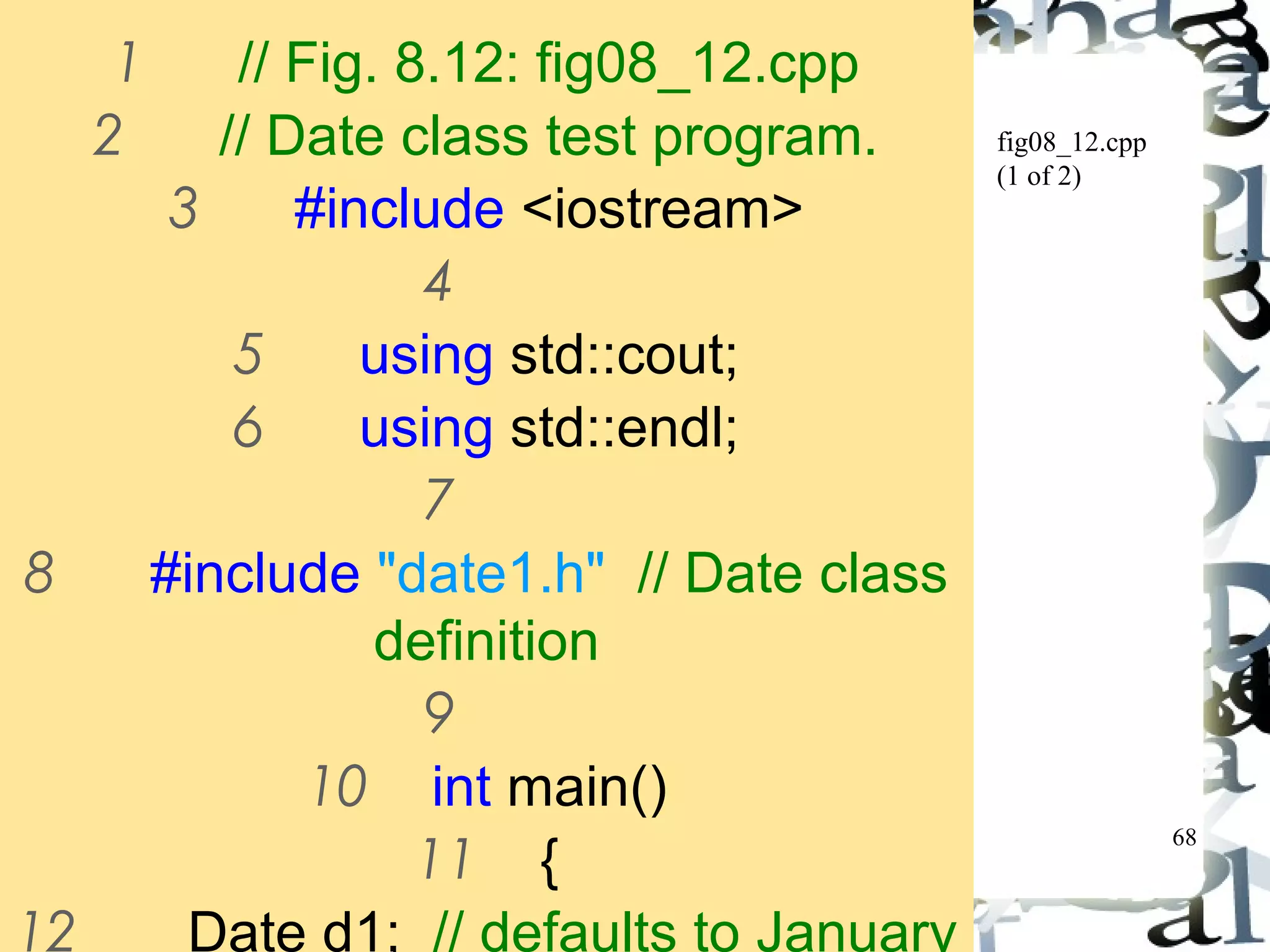
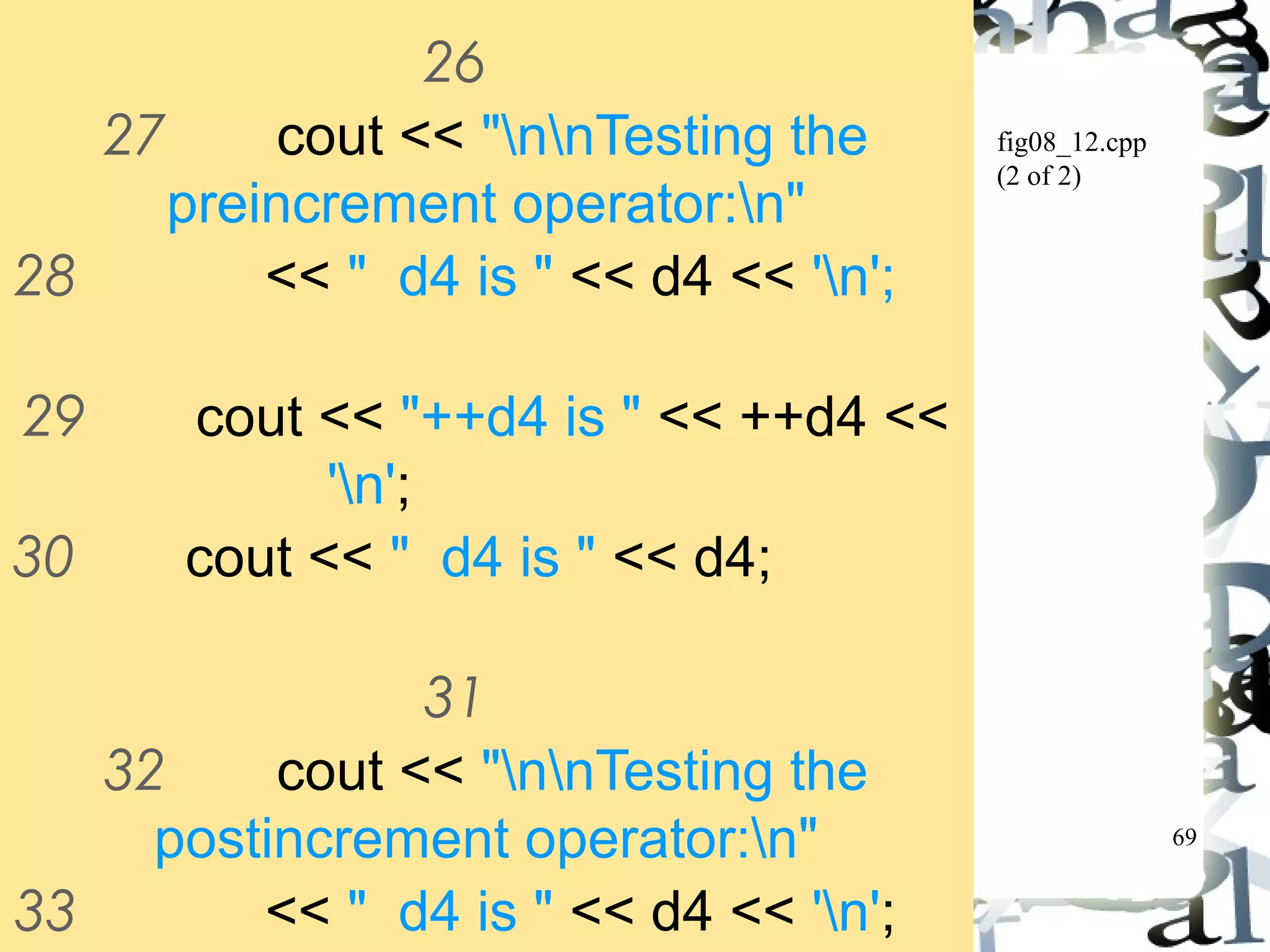
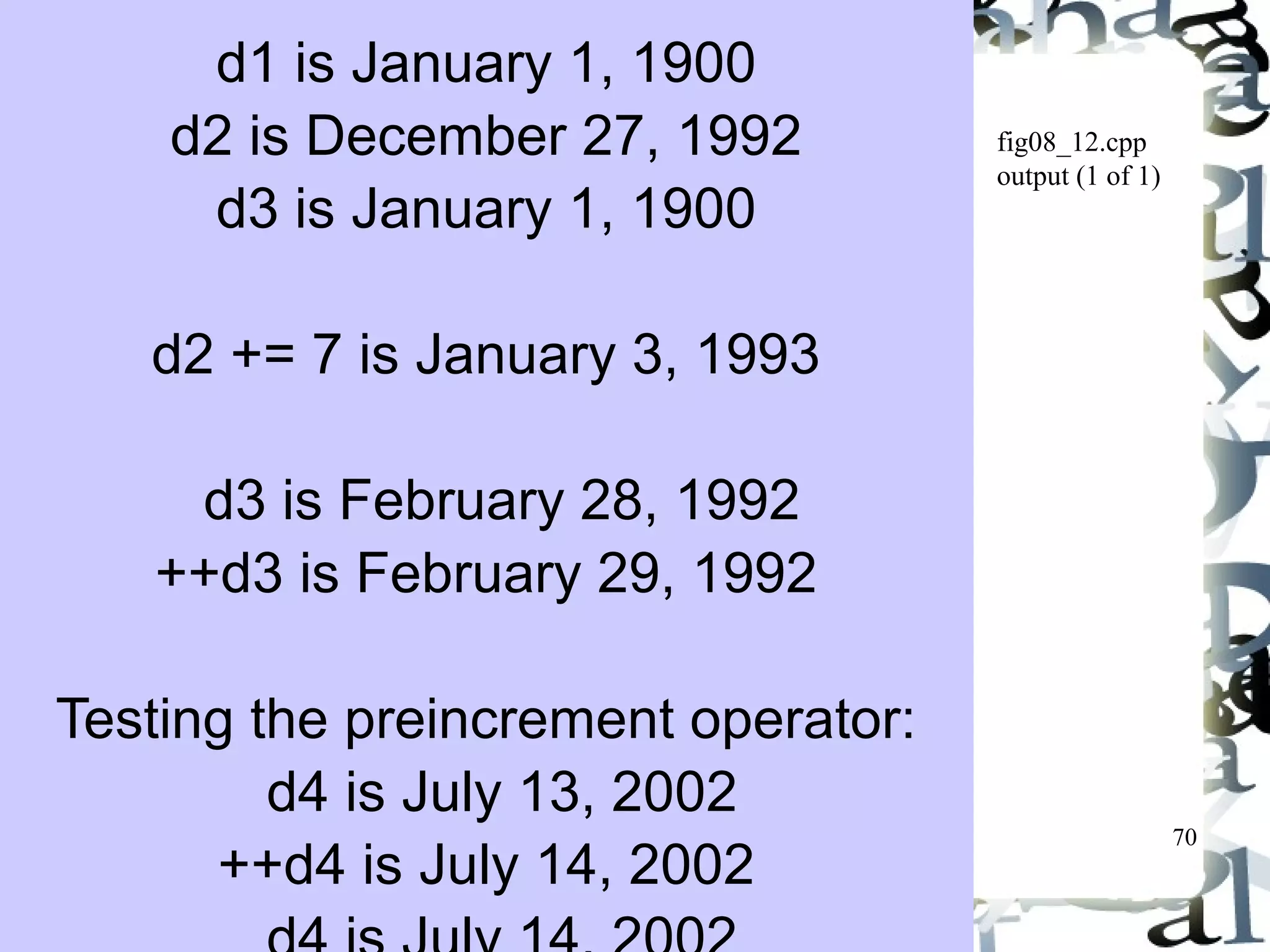
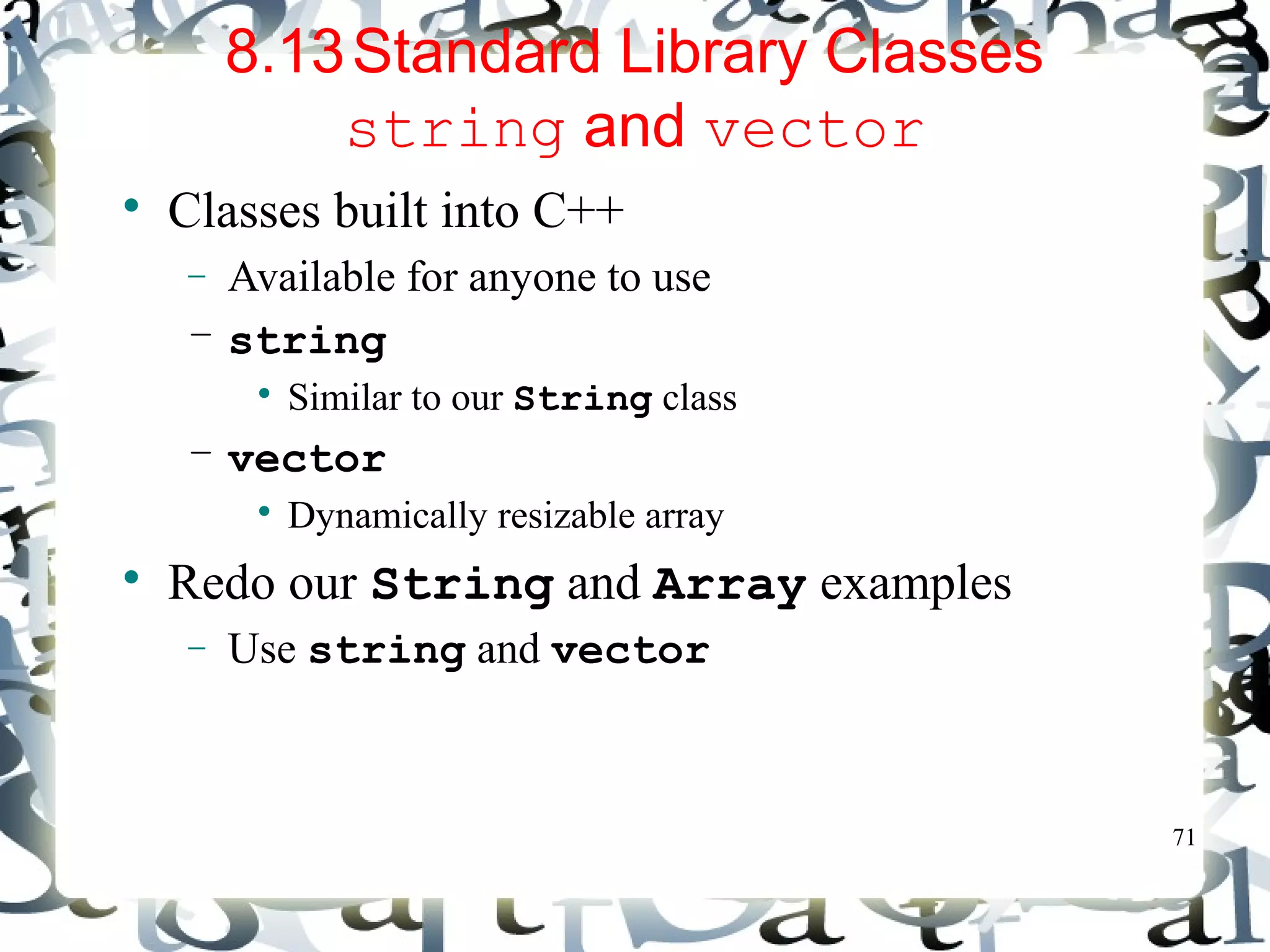
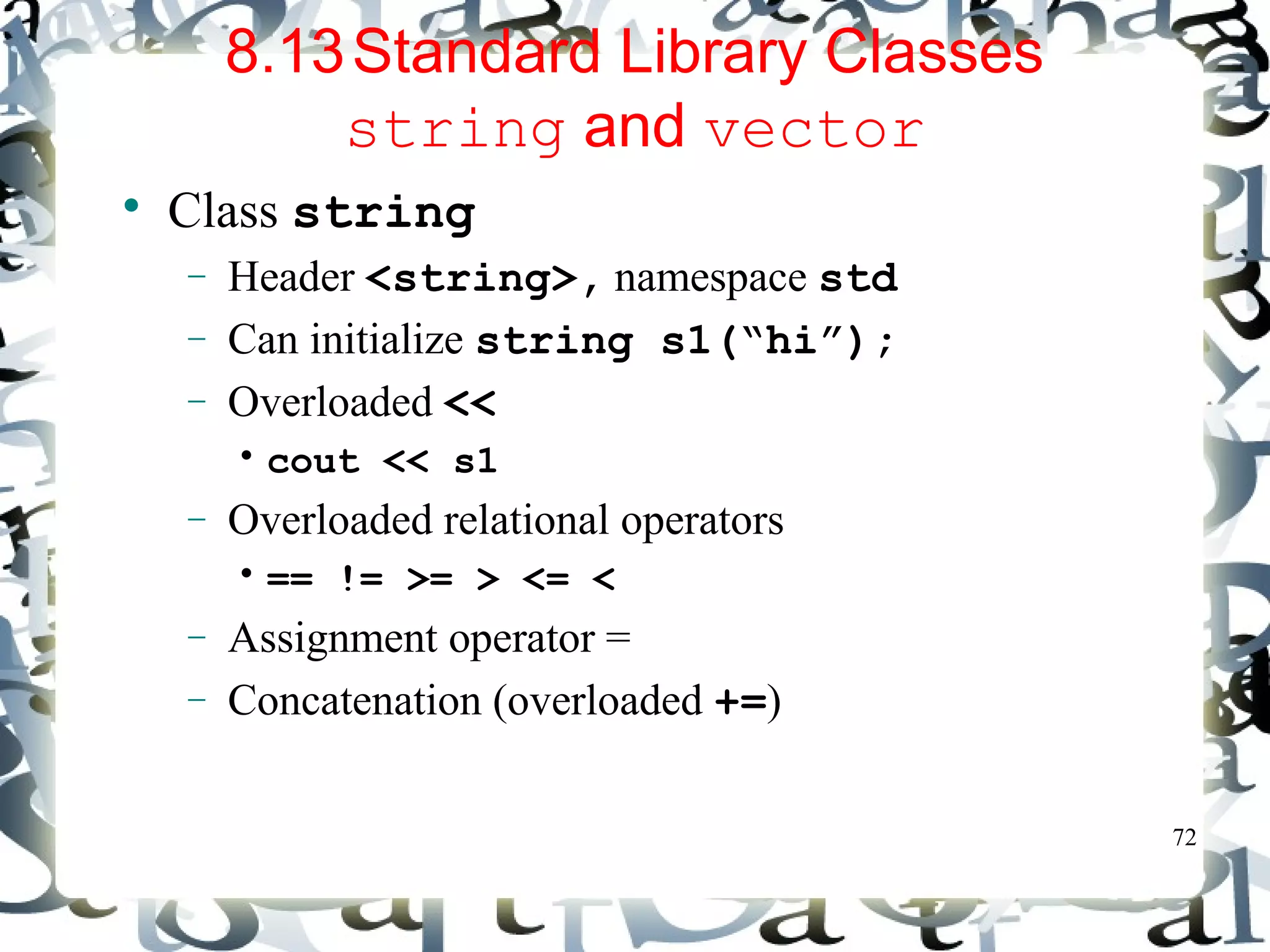
![73
8.13Standard Library Classes
string and vector
Class string
- Substring function substr
• s1.substr(0, 14);
- Starts at location 0, gets 14 characters
• S1.substr(15)
- Substring beginning at location 15
- Overloaded []
Access one character
No range checking (if subscript invalid)
– at function
• s1.at(10)
Character at subscript 10
Has bounds checking
- Will end program if invalid (learn more in Chapter 13)](https://image.slidesharecdn.com/synapseindiacomplainsharinginfoonchapter8-operatoroverloading-141101045042-conversion-gate02/75/Synapse-india-complain-sharing-info-on-chapter-8-operator-overloading-73-2048.jpg)


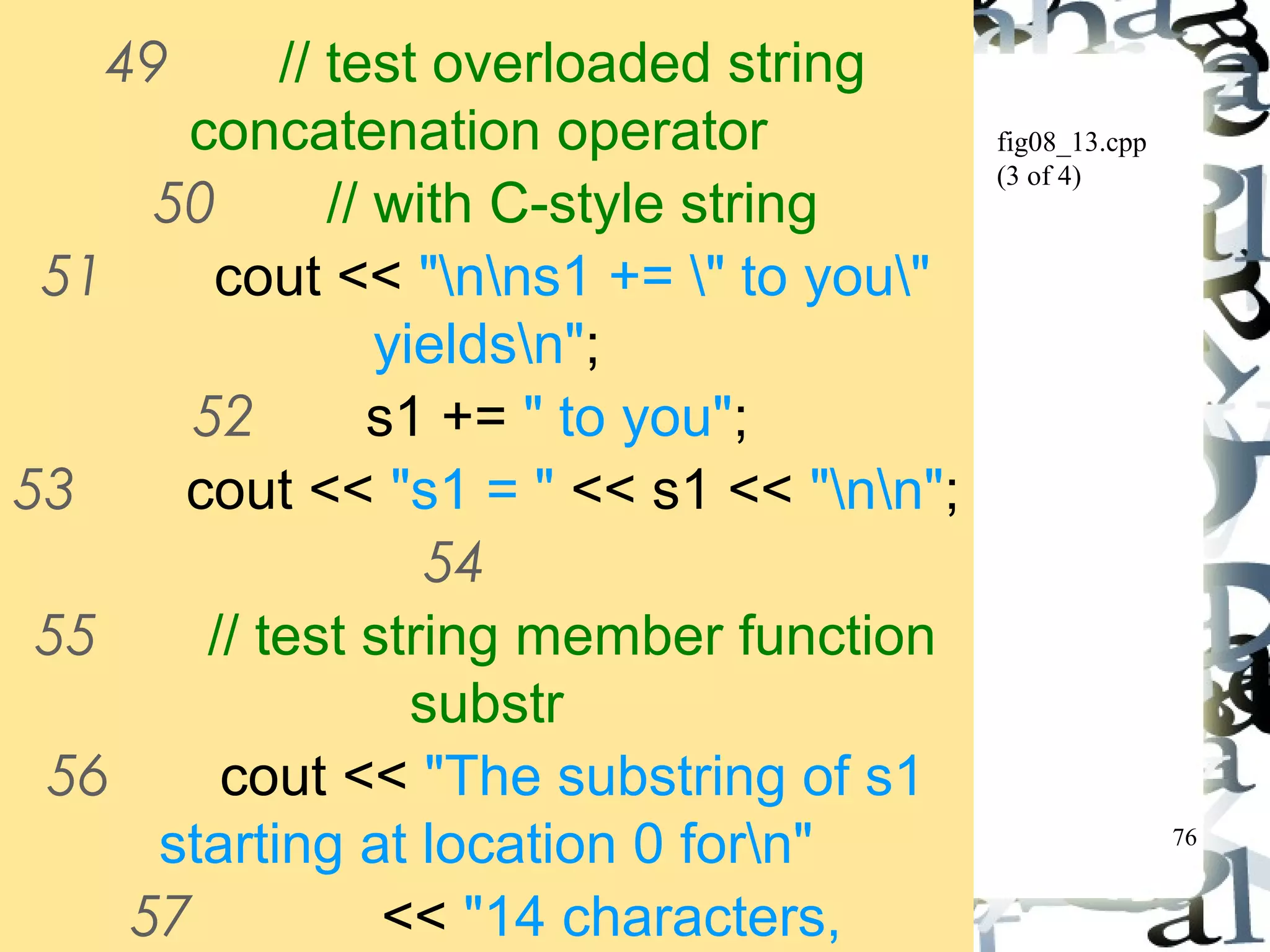
![77
fig08_13.cpp
(4 of 4)
74 // test destructor
75 delete s4Ptr;
76
77 // test using subscript operator
to create lvalue
78 s1[ 0 ] = 'H';
79 s1[ 6 ] = 'B';
80 cout << "ns1 after s1[0] = 'H'
and s1[6] = 'B' is: "
81 << s1 << "nn";
82
83 // test subscript out of range
with string member function "at"](https://image.slidesharecdn.com/synapseindiacomplainsharinginfoonchapter8-operatoroverloading-141101045042-conversion-gate02/75/Synapse-india-complain-sharing-info-on-chapter-8-operator-overloading-77-2048.jpg)
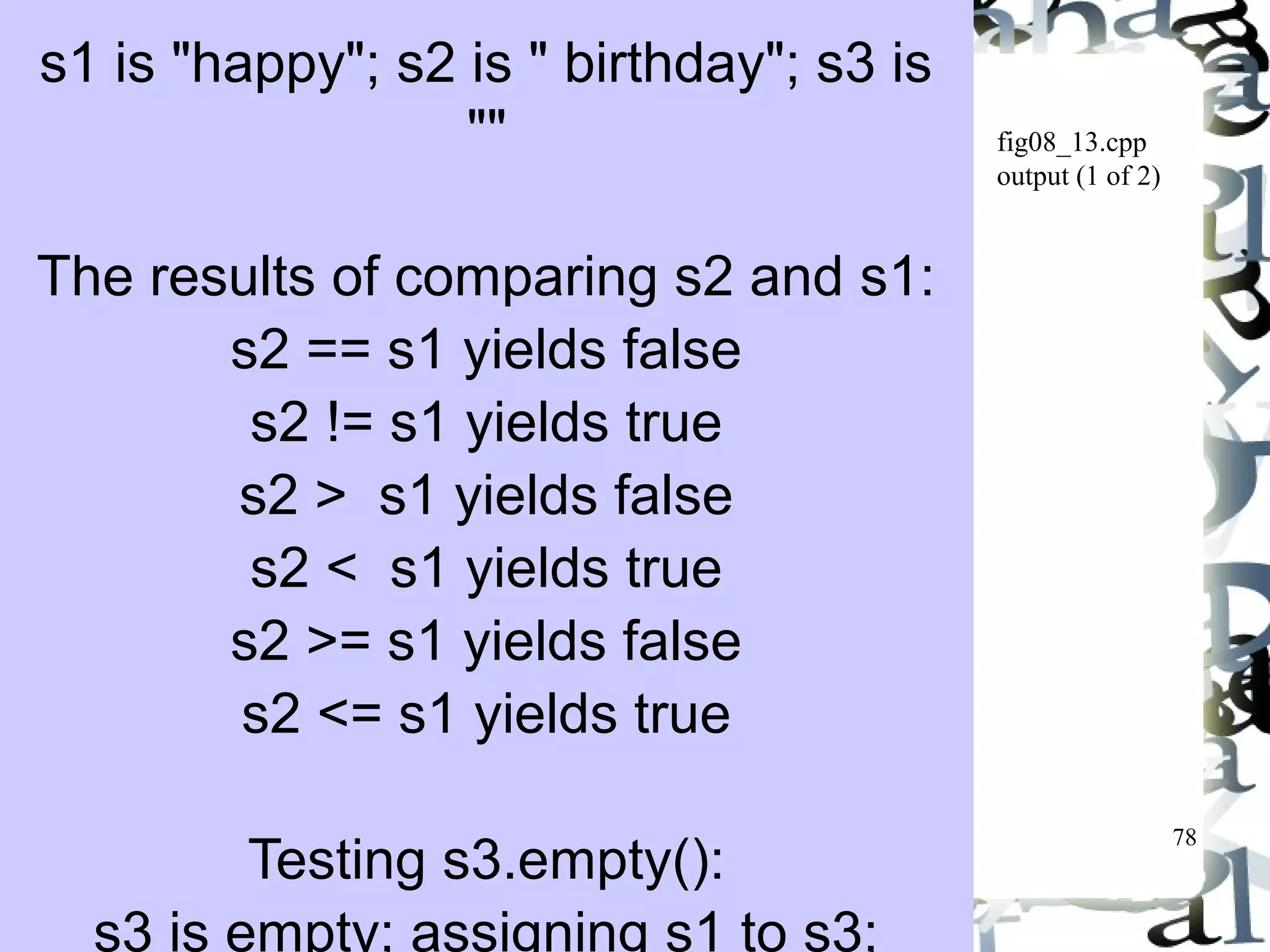
![79
fig08_13.cpp
output (2 of 2)
The substring of s1 starting at
location 15, s1.substr(15), is:
to you
*s4Ptr = happy birthday to you
assigning *s4Ptr to *s4Ptr
*s4Ptr = happy birthday to you
s1 after s1[0] = 'H' and s1[6] = 'B' is:
Happy Birthday to you
Attempt to assign 'd' to s1.at( 30 )](https://image.slidesharecdn.com/synapseindiacomplainsharinginfoonchapter8-operatoroverloading-141101045042-conversion-gate02/75/Synapse-india-complain-sharing-info-on-chapter-8-operator-overloading-79-2048.jpg)
![80
8.13Standard Library Classes
string and vector
Class vector
- Header <vector>, namespace std
- Store any type
• vector< int > myArray(10)
- Function size ( myArray.size() )
- Overloaded []
Get specific element, myArray[3]
- Overloaded !=, ==, and =
Inequality, equality, assignment](https://image.slidesharecdn.com/synapseindiacomplainsharinginfoonchapter8-operatoroverloading-141101045042-conversion-gate02/75/Synapse-india-complain-sharing-info-on-chapter-8-operator-overloading-80-2048.jpg)
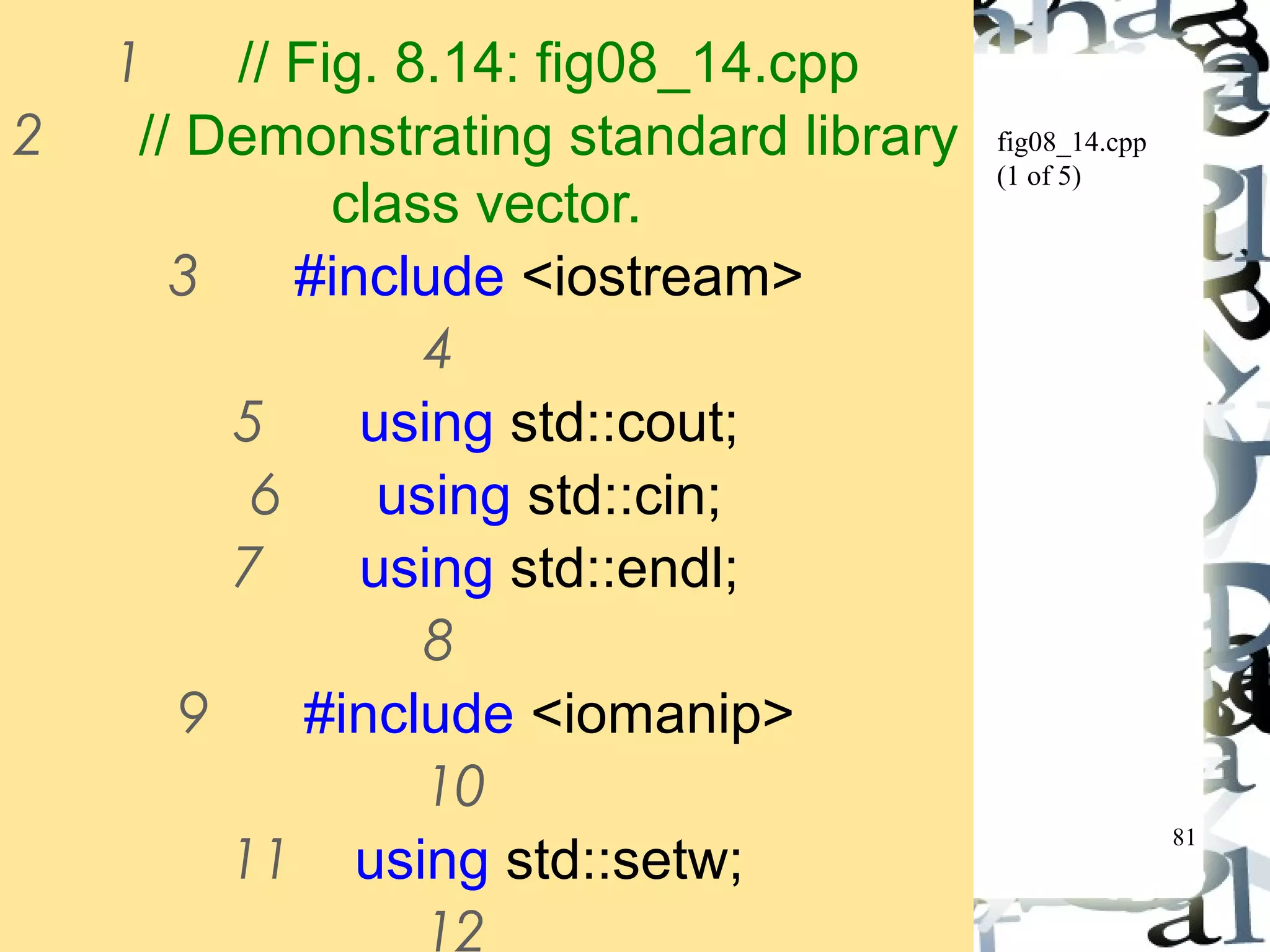
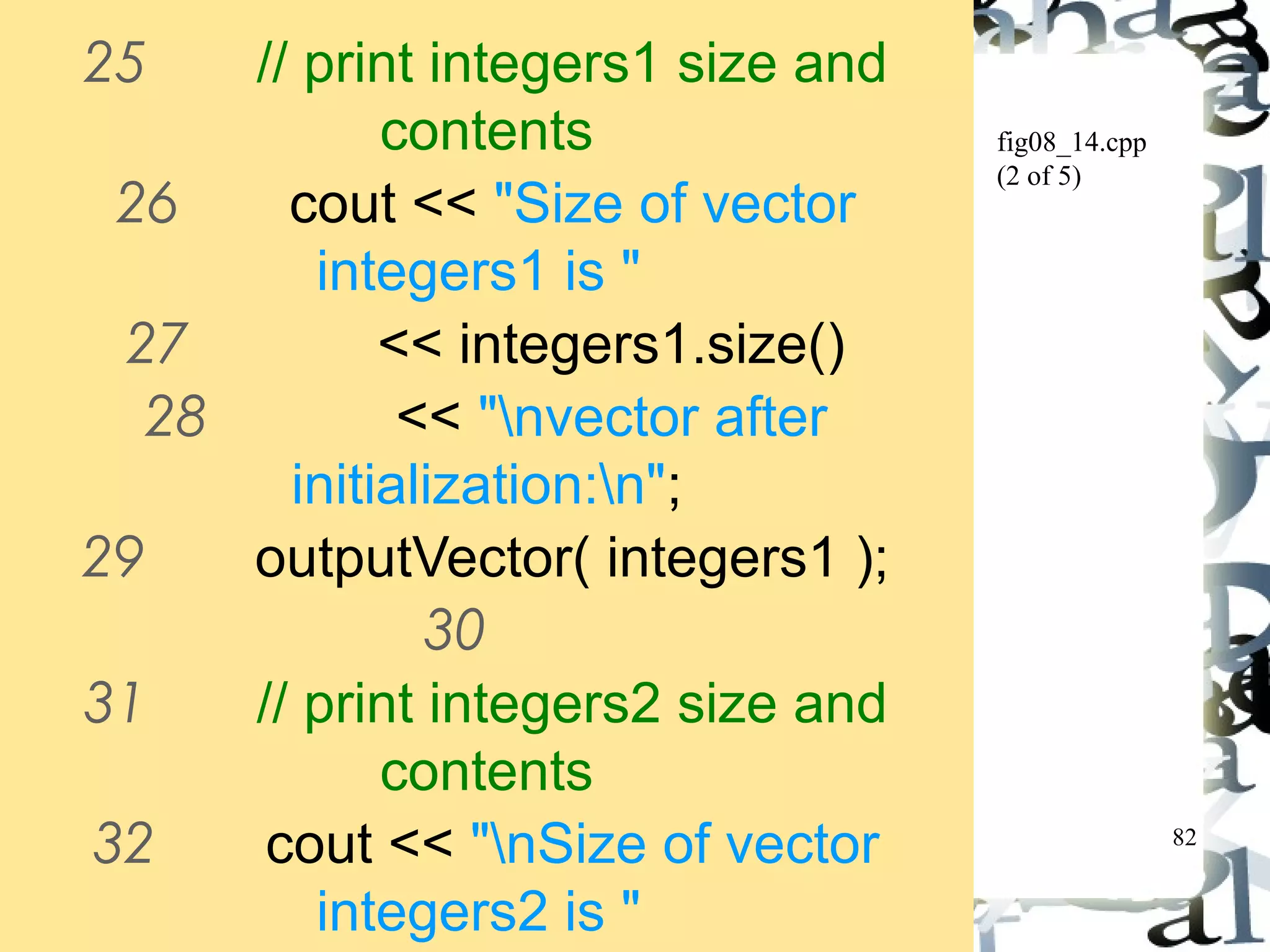

![84
fig08_14.cpp
(4 of 5)
73 // use overloaded equality (==)
operator
74 cout << "nEvaluating:
integers1 == integers2n";
75
76 if ( integers1 == integers2 )
77 cout << "integers1 and
integers2 are equaln";
78
79 // use overloaded subscript
operator to create rvalue
80 cout << "nintegers1[5] is " <<
integers1[ 5 ];
81](https://image.slidesharecdn.com/synapseindiacomplainsharinginfoonchapter8-operatoroverloading-141101045042-conversion-gate02/75/Synapse-india-complain-sharing-info-on-chapter-8-operator-overloading-84-2048.jpg)
![85
fig08_14.cpp
(5 of 5)
97 // output vector contents
98 void outputVector( const vector<
int > &array )
99 {
100 for ( int i = 0; i < array.size(); i+
+ ) {
101 cout << setw( 12 ) << array[ i
];
102
103 if ( ( i + 1 ) % 4 == 0 ) // 4
numbers per row of output
104 cout << endl;
105
106 } // end for](https://image.slidesharecdn.com/synapseindiacomplainsharinginfoonchapter8-operatoroverloading-141101045042-conversion-gate02/75/Synapse-india-complain-sharing-info-on-chapter-8-operator-overloading-85-2048.jpg)
